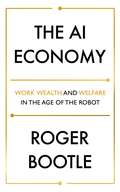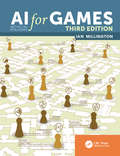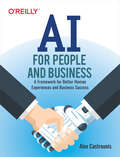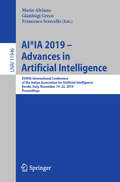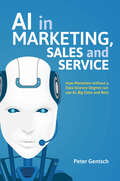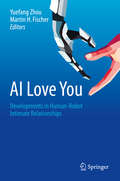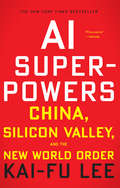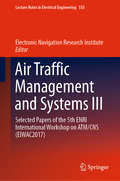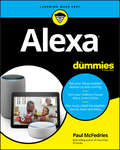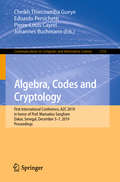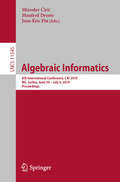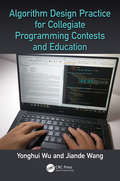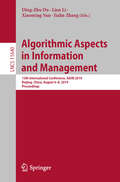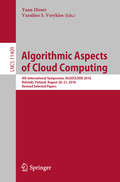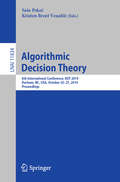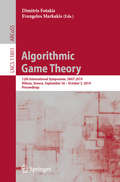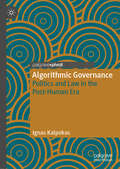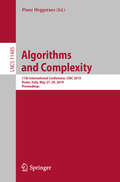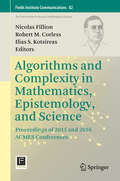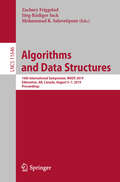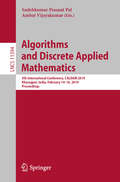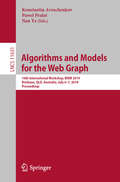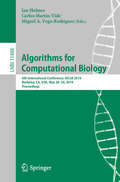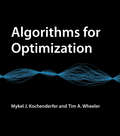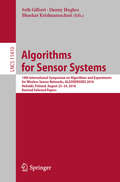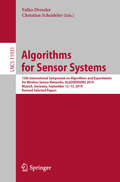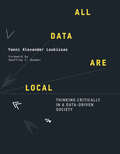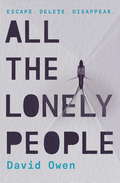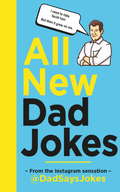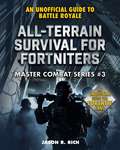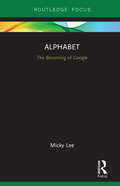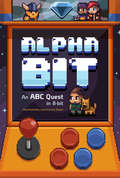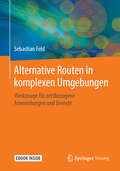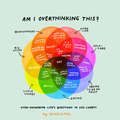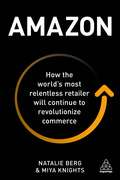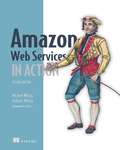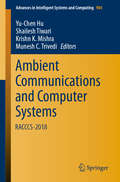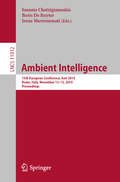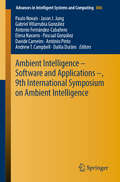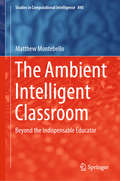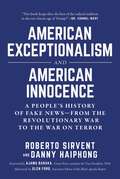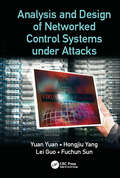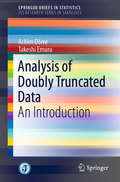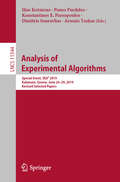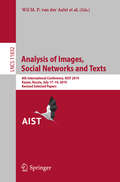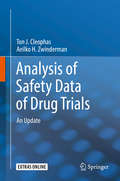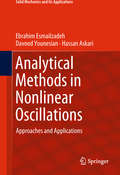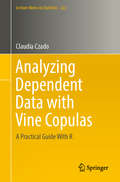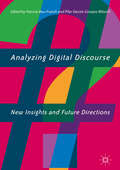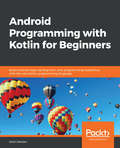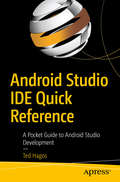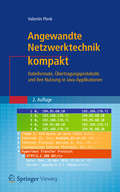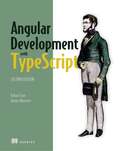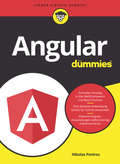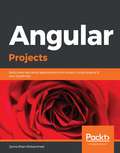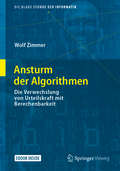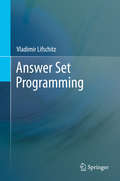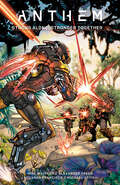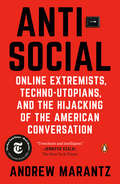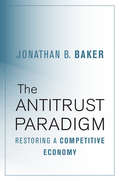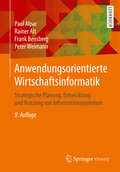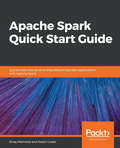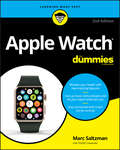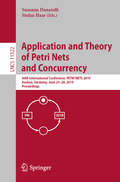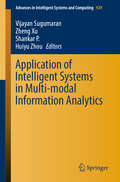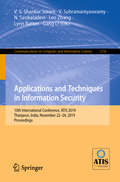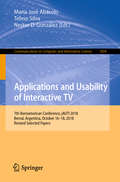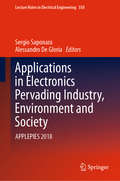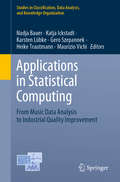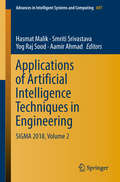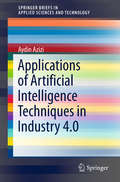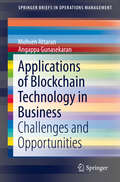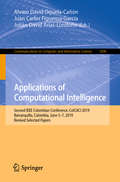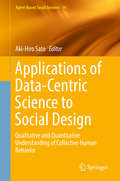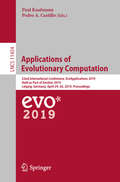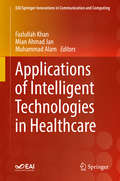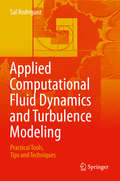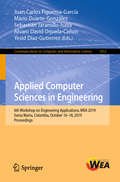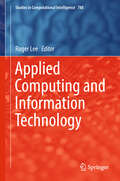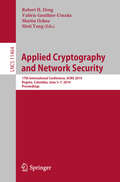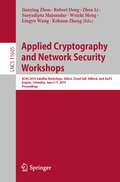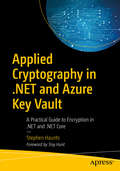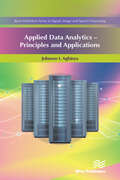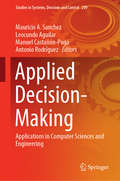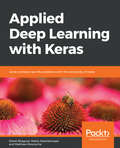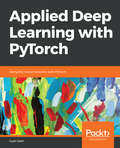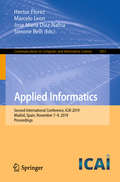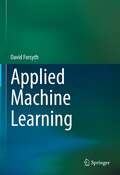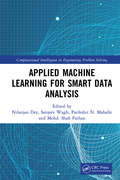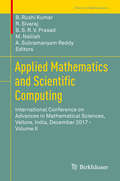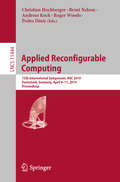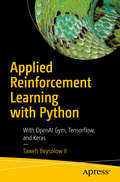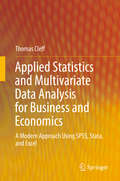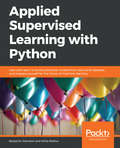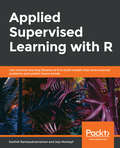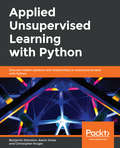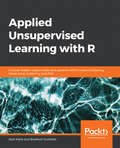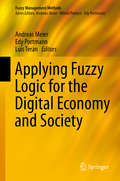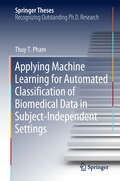- Table View
- List View
The AI Economy: Work, Wealth and Welfare in the Robot Age
by Roger Bootle'A well-researched, enjoyable and thoughtful book'. - Calum Chace, ForbesExtraordinary innovations in technology promise to transform the world, but how realistic is the claim that AI will change our lives? In this much needed book the acclaimed economist Roger Bootle responds to the fascinating economic questions posed by the age of the robot, steering a path away from tech jargon and alarmism towards a rational explanation of the ways in which the AI revolution will affect us all. Tackling the implications of Artificial Intelligence on growth, productivity, inflation and the distribution of wealth and power, THE AI ECONOMY also examines coming changes to the the way we educate, work and spend our leisure time.A fundamentally optimistic view which will help you plan for changing times, this book explains AI and leads you towards a more certain future.
AI for Games, Third Edition
by Ian MillingtonAI is an integral part of every video game. This book helps professionals keep up with the constantly evolving technological advances in the fast growing game industry and equips students with up-to-date information they need to jumpstart their careers. This revised and updated Third Edition includes new techniques, algorithms, data structures and representations needed to create powerful AI in games. Key Features A comprehensive professional tutorial and reference to implement true AI in games Includes new exercises so readers can test their comprehension and understanding of the concepts and practices presented Revised and updated to cover new techniques and advances in AI Walks the reader through the entire game AI development process
AI for People and Business: A Framework for Better Human Experiences and Business Success
by Alex CastrounisIf you’re an executive, manager, or anyone interested in leveraging AI within your organization, this is your guide. You’ll understand exactly what AI is, learn how to identify AI opportunities, and develop and execute a successful AI vision and strategy. Alex Castrounis, business consultant and former IndyCar engineer and race strategist, examines the value of AI and shows you how to develop an AI vision and strategy that benefits both people and business.AI is exciting, powerful, and game changing—but too many AI initiatives end in failure. With this book, you’ll explore the risks, considerations, trade-offs, and constraints for pursuing an AI initiative. You’ll learn how to create better human experiences and greater business success through winning AI solutions and human-centered products.Use the book’s AIPB Framework to conduct end-to-end, goal-driven innovation and value creation with AIDefine a goal-aligned AI vision and strategy for stakeholders, including businesses, customers, and usersLeverage AI successfully by focusing on concepts such as scientific innovation and AI readiness and maturityUnderstand the importance of executive leadership for pursuing AI initiatives"A must read for business executives and managers interested in learning about AI and unlocking its benefits. Alex Castrounis has simplified complex topics so that anyone can begin to leverage AI within their organization." - Dan Park, GM & Director, Uber"Alex Castrounis has been at the forefront of helping organizations understand the promise of AI and leverage its benefits, while avoiding the many pitfalls that can derail success. In this essential book, he shares his expertise with the rest of us." - Dean Wampler, Ph.D., VP, Fast Data Engineering at Lightbend
AI*IA 2019 – Advances in Artificial Intelligence: XVIIIth International Conference of the Italian Association for Artificial Intelligence, Rende, Italy, November 19–22, 2019, Proceedings (Lecture Notes in Computer Science #11946)
by Mario Alviano Gianluigi Greco Francesco ScarcelloThis book constitutes the proceedings of the XVIIIth International Conference of the Italian Association for Artificial Intelligence, AI*IA 2019, held in Rende, Italy, in November 2019. The 41 full papers were carefully reviewed and selected from 67 submissions. The papers have been organized in the following topical sections: Knowledge Representation for AI, AI and Computation, Machine Learning for AI, and AI and Humans.
AI in Marketing, Sales and Service: How Marketers without a Data Science Degree can use AI, Big Data and Bots
by Peter GentschAI and Algorithmics have already optimized and automated production and logistics processes. Now it is time to unleash AI on the administrative, planning and even creative procedures in marketing, sales and management.This book provides an easy-to-understand guide to assessing the value and potential of AI and Algorithmics. It systematically draws together the technologies and methods of AI with clear business scenarios on an entrepreneurial level. With interviews and case studies from those cutting edge businesses and executives who are already leading the way, this book shows you: how customer and market potential can be automatically identified and profiled; how media planning can be intelligently automated and optimized with AI and Big Data; how (chat)bots and digital assistants can make communication between companies and consumers more efficient and smarter; how you can optimize Customer Journeys based on Algorithmics and AI; and how to conduct market research in more efficient and smarter way. A decade from now, all businesses will be AI businesses – Gentsch shows you how to make sure yours makes that transition better than your competitors.
AI Love You: Developments in Human-Robot Intimate Relationships
by Martin H. Fischer Yuefang ZhouUsing an interdisciplinary approach, this book explores the emerging topics and rapid technological developments of robotics and artificial intelligence through the lens of the evolving role of sex robots, and how they should best be designed to serve human needs. An international panel of authors provides the most up-to-date, evidence-based empirical research on the potential sexual applications of artificial intelligence. Early chapters discuss the objections to sexual activity with robots while also providing a counterargument to each objection. Subsequent chapters present the implications of robot sex as well as the security and data privacy issues associated with sexual interactions with artificial intelligence. The book concludes with a chapter highlighting the importance of a scientific, multidisciplinary approach to the study of human - robot sexuality. Topics featured in this book include: The Sexual Interaction Illusion Model. The personal companion system, Harmony, designed by Realbotix™. An exposition of the challenges of personal data control and protection when dealing with artificial intelligence. The current and future technological possibilities of projecting three-dimensional holograms. Expert discussion notes from an international workshop on the topic. AI Love You will be of interest to academic researchers in psychology, robotics, ethics, medical science, sociology, gender studies as well as clinicians, policy makers, and the business sector.
AI Superpowers: China, Silicon Valley, and the New World Order
by Kai-Fu LeeDr. Kai-Fu Lee—one of the world’s most respected experts on AI and China—reveals that China has suddenly caught up to the US at an astonishingly rapid and unexpected pace. <P><P>In AI Superpowers, Kai-fu Lee argues powerfully that because of these unprecedented developments in AI, dramatic changes will be happening much sooner than many of us expected. Indeed, as the US-Sino AI competition begins to heat up, Lee urges the US and China to both accept and to embrace the great responsibilities that come with significant technological power. <P><P>Most experts already say that AI will have a devastating impact on blue-collar jobs. But Lee predicts that Chinese and American AI will have a strong impact on white-collar jobs as well. Is universal basic income the solution? <P><P> In Lee’s opinion, probably not. But he provides a clear description of which jobs will be affected and how soon, which jobs can be enhanced with AI, and most importantly, how we can provide solutions to some of the most profound changes in human history that are coming soon. <P><b>A New York Times Bestseller</b>
Air Traffic Management and Systems III: Selected Papers of the 5th ENRI International Workshop on ATM/CNS (EIWAC2017) (Lecture Notes in Electrical Engineering #555)
by Electronic Navigation Research InstituteThis proceedings provides novel concepts and techniques for air traffic management (ATM) and communications, navigation, and surveillance (CNS) systems. The volume consists of selected papers from the 5th ENRI International Workshop on ATM/CNS (EIWAC2017) held in Tokyo in November 2017, the theme of which was “Drafting Future Skies”. Included are key topics to realize safer and more efficient skies in the future, linked to the integrated conference theme consisting of long-term visions based on presentations from various fields. The proceedings is dedicated not only to researchers, academicians, and university students, but also to engineers in the industry, air navigation service providers (ANSPs), and regulators of aviation.
Alexa For Dummies
by Paul McFedriesUpgrade your Echo expertise with this Dummies guide to all things Alexa Amazon's hugely popular family of Echo devices has made Alexa a household name. She can answer your questions, entertain you, and even help around the house. Alexa for Dummies is the perfect guide for Alexa users who want to get up and running with their Echo devices. From basic setup to making the most of Alexa’s powerful smart home capabilities, this is your one-stop resource to all things Alexa. Whether you’ll use Alexa to send text messages, play music, control your thermostat, look up recipes, replenish your pantry, or just search the internet for information, you’ll find detailed instructions in this fun and easy-to-understand guide. Set up and personalize your Alexa device with an Amazon account and custom settings, including your preferred Alexa voice Use Alexa to play music throughout your home, stream videos online, and meet all your entertainment needs Unlock the power of advanced features like Alexa Skills and make your Alexa accessible Turn your ordinary house into a modern smart home with advanced smart home features and Echo accessories The virtual assistant you've dreamed of is now a reality with your favorite Echo device. Let Alexa For Dummies make your wish Alexa's command.
Algebra, Codes and Cryptology: First International Conference, A2C 2019 in honor of Prof. Mamadou Sanghare, Dakar, Senegal, December 5–7, 2019, Proceedings (Communications in Computer and Information Science #1133)
by Johannes Buchmann Edoardo Persichetti Cheikh Thiecoumba Gueye Pierre-Louis CayrelThis book presents refereed proceedings of the First International Conference on Algebra, Codes and Cryptology, A2C 2019, held in Dakar, Senegal, in December 2019.The 14 full papers were carefully reviewed and selected from 35 submissions. The papers are organized in topical sections on non-associative and non-commutative algebra; code, cryptology and information security.
Algebraic Informatics: 8th International Conference, CAI 2019, Niš, Serbia, June 30–July 4, 2019, Proceedings (Lecture Notes in Computer Science #11545)
by Miroslav Ćirić Manfred Droste Jean-Éric PinThis book constitutes the refereed proceedings of the 8th International Conference on Algebraic Informatics, CAI 2019, held in Niš, Serbia, in June/July 2019. The 20 revised papers presented were carefully reviewed and selected from 35 submissions. The papers present research at the intersection of theoretical computer science, algebra, and related areas. They report original unpublished research and cover a broad range of topics from automata theory and logic, cryptography and coding theory, computer algebra, design theory, natural and quantum computation, and related areas.
Algorithm Design Practice for Collegiate Programming Contests and Education
by Yonghui Wu Jiande WangThis book can be used as an experiment and reference book for algorithm design courses, as well as a training manual for programming contests. It contains 247 problems selected from ACM-ICPC programming contests and other programming contests. There's detailed analysis for each problem. All problems, and test datum for most of problems will be provided online. The content will follow usual algorithms syllabus, and problem-solving strategies will be introduced in analyses and solutions to problem cases. For students in computer-related majors, contestants and programmers, this book can polish their programming and problem-solving skills with familarity of algorithms and mathematics.
Algorithmic Aspects in Information and Management: 13th International Conference, AAIM 2019, Beijing, China, August 6–8, 2019, Proceedings (Lecture Notes in Computer Science #11640)
by Ding-Zhu Du Lian Li Xiaoming Sun Jialin ZhangThis volume constitutes the proceedings of the 13th International Conference on Algorithmic Aspects in Information and Management, AAIM 2019, held in Bejing, China in August 2019. The 31 full papers presented were carefully reviewed and selected. The papers deal with most aspects of theoretical computer science and their applications. Special considerations are given to algorithmic research that is motivated by real-world applications.
Algorithmic Aspects of Cloud Computing: 4th International Symposium, ALGOCLOUD 2018, Helsinki, Finland, August 20–21, 2018, Revised Selected Papers (Lecture Notes in Computer Science #11409)
by Yann Disser Vassilios S. VerykiosThis book constitutes the refereed post-conference proceedings of the 4th International Symposium on Algorithmic Aspects of Cloud Computing, ALGOCLOUD 2018, held in Helsinki, Finland, in August 2018. The 11 revised full papers were carefully reviewed and selected from 29 submissions. The aim of the symposium is to present research activities and results on topics related to algorithmic, design, and development aspects of modern cloud-based systems.
Algorithmic Decision Theory: 6th International Conference, ADT 2019, Durham, NC, USA, October 25–27, 2019, Proceedings (Lecture Notes in Computer Science #11834)
by Saša Pekeč Kristen Brent VenableThis book constitutes the conference proceedings of the 6th International Conference on Algorithmic Decision Theory, ADT 2019, held in Durham, NC, USA, in October 2019. The 10 full papers presented together with 7 short papers were carefully selected from 31 submissions. The papers focus on algorithmic decision theory broadly defined, seeking to bring together researchers and practitioners coming from diverse areas of computer science, economics and operations research in order to improve the theory and practice of modern decision support.
Algorithmic Game Theory: 12th International Symposium, SAGT 2019, Athens, Greece, September 30 – October 3, 2019, Proceedings (Lecture Notes in Computer Science #11801)
by Dimitris Fotakis Evangelos MarkakisThis book constitutes the refereed proceedings of the 12th International Symposium on Algorithmic Game Theory, SAGT 2019, held in Athens, Greece, in September/October 2019. The 25 full papers presented together with 3 invited talks and one abstract paper were carefully reviewed and selected from 55 submissions. The papers are organized in topical sections named: Algorithmic Mechanism Design; Auctions and Markets; Computational Aspects of Games; Network Games and Congestion Games; Social Choice; and Matchings and Fair Division.
Algorithmic Governance: Politics and Law in the Post-Human Era
by Ignas KalpokasThis book analyses the changes to the regulation of everyday life that have taken place as a result of datafication, the ever-growing analytical, predictive, and structuring role of algorithms, and the prominence of the platform economy. This new form of regulation – algorithmic governance – ranges from nudging individuals towards predefined outcomes to outright structuration of behaviour through digital architecture. The author reveals the strength and pervasiveness of algorithmic politics through a comparison with the main traditional form of regulation: law. These changes are subsequently demonstrated to reflect a broader shift away from anthropocentric accounts of the world. In doing so, the book adopts a posthumanist framework which focuses on deep embeddedness and interactions between humans, the natural environment, technology, and code.
Algorithms and Complexity: 11th International Conference, CIAC 2019, Rome, Italy, May 27–29, 2019, Proceedings (Lecture Notes in Computer Science #11485)
by Pinar HeggernesThis book constitutes the refereed conference proceedings of the 11th International Conference on Algorithms and Complexity, CIAC 2019, held in Rome, Italy, in May 2019. The 30 full papers were carefully reviewed and selected from 95 submissions. The International Conference on Algorithms and Complexity is intended to provide a forum for researchers working in all aspects of computational complexity and the use, design, analysis and experimentation of efficient algorithms and data structures. The papers present original research in the theory and applications of algorithms and computational complexity.
Algorithms and Complexity in Mathematics, Epistemology, and Science: Proceedings of 2015 and 2016 ACMES Conferences (Fields Institute Communications #82)
by Nicolas Fillion Robert M. Corless Ilias S. KotsireasACMES (Algorithms and Complexity in Mathematics, Epistemology, and Science) is a multidisciplinary conference series that focuses on epistemological and mathematical issues relating to computation in modern science. This volume includes a selection of papers presented at the 2015 and 2016 conferences held at Western University that provide an interdisciplinary outlook on modern applied mathematics that draws from theory and practice, and situates it in proper context. These papers come from leading mathematicians, computational scientists, and philosophers of science, and cover a broad collection of mathematical and philosophical topics, including numerical analysis and its underlying philosophy, computer algebra, reliability and uncertainty quantification, computation and complexity theory, combinatorics, error analysis, perturbation theory, experimental mathematics, scientific epistemology, and foundations of mathematics. By bringing together contributions from researchers who approach the mathematical sciences from different perspectives, the volume will further readers' understanding of the multifaceted role of mathematics in modern science, informed by the state of the art in mathematics, scientific computing, and current modeling techniques.
Algorithms and Data Structures: 16th International Symposium, WADS 2019, Edmonton, AB, Canada, August 5–7, 2019, Proceedings (Lecture Notes in Computer Science #11646)
by Zachary Friggstad Jörg-Rüdiger Sack Mohammad R. SalavatipourThis book constitutes the refereed proceedings of the 16th International Symposium on Algorithms and Data Structures, WADS, 2019, held in Edmonton, AB, Canada, in August 2019. The 42 full papers presented together with 3 invited lectures, we carefully reviewed and selected from a total of 88 submissions. They present original research on the theory and application of algorithms and data structures in many areas, including combinatorics, computational geometry, databases, graphics, and parallel and distributed computing.
Algorithms and Discrete Applied Mathematics: 5th International Conference, CALDAM 2019, Kharagpur, India, February 14-16, 2019, Proceedings (Lecture Notes in Computer Science #11394)
by Sudebkumar Prasant Pal Ambat VijayakumarThis book constitutes the proceedings of the 5th International Conference on Algorithms and Discrete Applied Mathematics, CALDAM 2019, held in Kharagpur, India, in February 2019. The 22 papers presented together with 3 invited papers in this volume were carefully reviewed and selected from 86 submissions. The conference had papers in the areas of algorithms, graph theory, combinatorics, computational geometry, discrete geometry, and computational complexity.
Algorithms and Models for the Web Graph: 16th International Workshop, WAW 2019, Brisbane, QLD, Australia, July 6–7, 2019, Proceedings (Lecture Notes in Computer Science #11631)
by Konstantin Avrachenkov Paweł Prałat Nan YeThis book constitutes the proceedings of the 16th International Workshop on Algorithms and Models for the Web Graph, WAW 2019, held in Brisbane, QLD, Australia, in July 2019. The 9 full papers presented in this volume were carefully reviewed and selected from 13 submissions. The papers cover topics of all aspects of algorithmic and mathematical research in the areas pertaining to the World Wide Web, espousing the view of complex data as networks.
Algorithms for Computational Biology: 6th International Conference, AlCoB 2019, Berkeley, CA, USA, May 28–30, 2019, Proceedings (Lecture Notes in Computer Science #11488)
by Ian Holmes Carlos Martín-Vide Miguel A. Vega-RodríguezThis book constitutes the proceedings of the 6th InternationalConference on Algorithms for Computational Biology, AlCoB 2019, held in Berkeley, CA, USA, in May 2019. The 15 full papers presented together with 1 invited paper were carefully reviewed and selected from 30 submissions. They are organized in the following topical sections: Biological networks and graph algorithms; genome rearrangement, assembly and classification; sequence analysis, phylogenetics and other biological processes.
Algorithms for Optimization
by Mykel J. Kochenderfer Tim A. WheelerA comprehensive introduction to optimization with a focus on practical algorithms for the design of engineering systems. This book offers a comprehensive introduction to optimization with a focus on practical algorithms. The book approaches optimization from an engineering perspective, where the objective is to design a system that optimizes a set of metrics subject to constraints. Readers will learn about computational approaches for a range of challenges, including searching high-dimensional spaces, handling problems where there are multiple competing objectives, and accommodating uncertainty in the metrics. Figures, examples, and exercises convey the intuition behind the mathematical approaches. The text provides concrete implementations in the Julia programming language. Topics covered include derivatives and their generalization to multiple dimensions; local descent and first- and second-order methods that inform local descent; stochastic methods, which introduce randomness into the optimization process; linear constrained optimization, when both the objective function and the constraints are linear; surrogate models, probabilistic surrogate models, and using probabilistic surrogate models to guide optimization; optimization under uncertainty; uncertainty propagation; expression optimization; and multidisciplinary design optimization. Appendixes offer an introduction to the Julia language, test functions for evaluating algorithm performance, and mathematical concepts used in the derivation and analysis of the optimization methods discussed in the text. The book can be used by advanced undergraduates and graduate students in mathematics, statistics, computer science, any engineering field, (including electrical engineering and aerospace engineering), and operations research, and as a reference for professionals.
Algorithms for Sensor Systems: 14th International Symposium on Algorithms and Experiments for Wireless Sensor Networks, ALGOSENSORS 2018, Helsinki, Finland, August 23–24, 2018, Revised Selected Papers (Lecture Notes in Computer Science #11410)
by Seth Gilbert Danny Hughes Bhaskar KrishnamachariThis book constitutes revised selected papers from the 14th International Symposium on Algorithms and Experiments for Wireless Sensor Networks, ALGOSENSORS 2018, held in Helsinki, Finland, in August 2018.The 15 full papers presented in this volume were carefully reviewed and selected from 39 submissions. ALGOSENSORS is an international symposium dedicated to the algorithmic aspects of wireless networks. Originally focused on sensor networks, it now covers algorithmic issues arising in wireless networks of all types of computational entities, static or mobile, including sensor networks, sensor-actuator networks, autonomous robots. The focus is on the design and analysis of algorithms, models of computation, and experimental analysis.
Algorithms for Sensor Systems: 15th International Symposium on Algorithms and Experiments for Wireless Sensor Networks, ALGOSENSORS 2019, Munich, Germany, September 12–13, 2019, Revised Selected Papers (Lecture Notes in Computer Science #11931)
by Falko Dressler Christian ScheidelerThis book constitutes revised selected papers from the 15th International Symposium on Algorithms and Experiments for Wireless Sensor Networks, ALGOSENSORS 2019, held in Munich, Germany, in September 2019. The 11 full papers presented in this volume were carefully reviewed and selected from 16 submissions. ALGOSENSORS is an international symposium dedicated to the algorithmic aspects of wireless networks.
All Data Are Local: Thinking Critically in a Data-Driven Society
by Yanni Alexander LoukissasHow to analyze data settings rather than data sets, acknowledging the meaning-making power of the local.In our data-driven society, it is too easy to assume the transparency of data. Instead, Yanni Loukissas argues in All Data Are Local, we should approach data sets with an awareness that data are created by humans and their dutiful machines, at a time, in a place, with the instruments at hand, for audiences that are conditioned to receive them. The term data set implies something discrete, complete, and portable, but it is none of those things. Examining a series of data sources important for understanding the state of public life in the United States—Harvard's Arnold Arboretum, the Digital Public Library of America, UCLA's Television News Archive, and the real estate marketplace Zillow—Loukissas shows us how to analyze data settings rather than data sets.Loukissas sets out six principles: all data are local; data have complex attachments to place; data are collected from heterogeneous sources; data and algorithms are inextricably entangled; interfaces recontextualize data; and data are indexes to local knowledge. He then provides a set of practical guidelines to follow. To make his argument, Loukissas employs a combination of qualitative research on data cultures and exploratory data visualizations. Rebutting the “myth of digital universalism,” Loukissas reminds us of the meaning-making power of the local.
All The Lonely People
by David Owen'I loved it . . . There's nothing out there like All The Lonely People - it's uniquely brilliant, bold and not afraid to shout about what's wrong with the world, while still showing how subtle changes and hope can save lives. Original, shocking, eye-opening and thoroughly enjoyable' Simon P Clark, author of ErenEveryone tells Kat that her online personality - confident, funny, opinionated - isn't her true self. Kat knows otherwise. The internet is her only way to cope with a bad day, chat with friends who get all her references, make someone laugh. But when she becomes the target of an alt-right trolling campaign, she feels she has no option but to Escape, Delete, Disappear. With her social media shut down, her website erased, her entire online identity void, Kat feels she has cut away her very core: without her virtual self, who is she? She brought it on herself. Or so Wesley keeps telling himself as he dismantles Kat's world. It's different, seeing one of his victims in real life and not inside a computer screen - but he's in too far to back out now. As soon as Kat disappears from the online world, her physical body begins to fade and while everybody else forgets that she exists, Wesley realises he is the only one left who remembers her. Overcome by remorse for what he has done, Wesley resolves to stop her disappearing completely. It might just be the only way to save himself.All the Lonely People is a timely story about online culture - both good and bad - that explores the experience of loneliness in a connected world, and the power of kindness and empathy over hatred.
All New Dad Jokes: The perfect gift from the Instagram sensation @DadSaysJokes
by Dad Says JokesTHE BRAND-NEW BOOK FROM @DADSAYSJOKESAll New Dad Jokes is the second book from the most followed dad jokes page on Instagram, @DadSaysJokes. Now with a following of over 1 million, All New Dad Jokes provides brand new gags guaranteed to leave your friends and family laughing and groaning in equal measure.@DadSaysJokes is a community-run Instagram account with more than a million followers, inspired by the daily jokes of author Kit Chilvers' dad, Andrew. Every day, followers submit their jokes and the team picks their favourites - or Dad just drops in his own zinger! Kit, a young social networking mastermind started his career at the tender age of 14, when he created his original platform, Football.Newz, to serve audiences for the World cup 2014. He has recently added another nine platforms in different genres (of which @DadSaysJokes is one), with nine million followers and rising. This is his second book. Q: Where do naughty rainbows go?A: Prism.
All New Dad Jokes: The perfect gift from the Instagram sensation @DadSaysJokes
by Dad Says JokesALL NEW CONTENT FROM THE ORIGINAL BESTSELLERAll New Dad Jokes is the second book from the most followed dad jokes page on Instagram, @DadSaysJokes. Now with a following of over 1 million, All New Dad Jokes provides brand new gags guaranteed to leave your friends and family laughing and groaning in equal measure.@DadSaysJokes is a community-run Instagram account with more than a million followers, inspired by the daily jokes of author Kit Chilvers' dad, Andrew. Every day, followers submit their jokes and the team picks their favourites - or Dad just drops in his own zinger! Kit, a young social networking mastermind started his career at the tender age of 14, when he created his original platform, Football.Newz, to serve audiences for the World cup 2014. He has recently added another nine platforms in different genres (of which @DadSaysJokes is one), with nine million followers and rising. This is his second book. Q: Where do naughty rainbows go?A: Prism.
All-Terrain Survival for Fortniters: An Unofficial Guide to Battle Royale (Master Combat)
by Jason RichKnow your terrain and use it to your advantage with All-Terrain Survival. This all-new, unofficial, illustrated guide series will turn you into a master Fortnite: Battle Royale gamer by uncovering all the best strategies and secrets of this wildly popular game. Whether you play Fortnite: Battle Royale on a PC, Mac, Xbox One, PlayStation 4, or your mobile device, you’ll find everything you need to stay at the top of your game. <P><P>Each book is packed with useful insider tips on topics like, staying alive longer, exploring, collecting a powerful arsenal, building, and snagging more victories during each match. When it comes to achieving #1 Victory Royale, the Fortnite Battle Royale: Master Combat Series provides the ultimate competitive edge. There are more than a dozen unique points of interest in Fortnite, all with different settings. <P><P>The best gamers know how to soldier their way through deserts, tropics, forests, villages, cities, ice-covered plains, mountains, small islands, and any other terrain they encounter. Thanks to this illustrated, how-to guide, you can learn to spot the key differences between terrains, rise to the unique challenge each one poses, and master each setting where matches are held. <P><P>Use the tips and secrets in this book to explore, survive, and battle your way to #1 Victory Royale. Master Combat: All-Terrain Survival has everything you need to tough-it-out through every terrain and be the last soldier standing.
Alphabet: The Becoming of Google (Global Media Giants)
by Micky LeeGoogle is synonymous with searching, but in this innovative new research volume, Micky Lee explores how the Alphabet Corporation, now the parent company of Google, is more than just a search engine. Using a political economic approach, Lee draws on the concept of networks to investigate the growth of this key media player. The establishment of the parent company, Alphabet, shows the company is expanding to other industries from equity investment to self-driving cars. This book first examines this history of expansion, before delving into the economic, political, and cultural profiles of the corporation. Lee ultimately finds that what makes Google powerful is not one genius idea, but rather networks of people, places, and capital. Alphabet: The Becoming of Google is a compelling dive into the sometimes inscrutable world of Google, ideal for students, scholars, and researchers interested in the fields of digital media studies, the politics and economies of online media, and the history of the internet.
AlphaBit: An ABC Quest in 8-Bit
by Chronicle BooksInspired by classic video games of the '80s and '90s, this clever board book sets out to level up the ABCs. Within these pages lies an alphabet adventure, rendered entirely in striking 8-bit artwork. Young gamers will love guiding their daring hero through the story to learn new words, discover hidden pictures, and find the missing treasure in an epic quest that will have kids and adults ready to press restart!
Alternative Routen in komplexen Umgebungen: Werkzeuge für ortsbezogene Anwendungen und Dienste
by Sebastian FeldDas Buch zeigt verschiedene Ansätze und Verfahren, um alternative Routen in Freiflächen zu berechnen, geospatiale Trajektorien zu vergleichen sowie Strukturen in Gebäuden zu identifizieren. Die Wegefindung in komplexen Umgebungen unterscheidet sich von der in Straßennetzen vor allem dadurch, dass sich eine Person nahezu in alle Richtungen bewegen kann. Das Vorhalten von alternativen Routen für Fußgänger (aber auch für mobile Roboter) in Flughäfen, Krankenhäusern, Messehallen, Parks, Industrieanlagen oder Lagerhallen ermöglicht beispielsweise eine personalisierte Navigation, sodass proaktiv Stau vermieden oder blockierten Bereichen ausgewichen wird.Im ersten Teil des Buches definiert der Autor alternative Routen in komplexen Umgebungen, stellt den Algorithmus zum Berechnen solcher Routen vor und geht auf Qualitätsmetriken sowie Alternativgraphen ein. Im zweiten Teil legt Sebastian Feld unter anderem ein System zum Vergleich von Routen vor, mit dem aus einer Menge von Routen die extremsten Exemplare extrahiert werden können. Schließlich integriert er im dritten Teil des Buches die quantitative Analyse der visuellen Wahrnehmung von Raum in den Kontext alternativer Routen. Damit bietet das Buch einen Werkzeugkasten, der von weiteren ortsbezogenen Anwendungen und Diensten verwendet werden kann.
Am I Overthinking This?: Over-answering life's questions in 101 charts
by Michelle RialDid I screw up? How do I achieve work-life balance? Am I eating too much cheese? Do I have too many plants? Through artful charts and funny, insightful questions, Michelle Rial delivers a playful take on the little dilemmas that loom large in the mind of every adult. Building on her popular Instagram account, Am I Overthinking This? brings whimsical charm to topics big and small, and offers solidarity for the stressed, answers for the confused, and a good laugh for all.
Amazon: How the World’s Most Relentless Retailer will Continue to Revolutionize Commerce
by Natalie Berg Miya KnightsThe retail industry is facing unprecedented challenges. Across all sectors and markets, retailers are shifting their business models and customer engagement strategies to ensure their survival. The rise of online shopping, and its primary player, Amazon, is at the heart of many of these changes and opportunities. Amazon explores the e-commerce giant's strategies, providing original insight at a time when the company is on the cusp of revolutionizing itself even further. Amazon's relentless dissatisfaction with the status quo is what makes it such an extraordinary retailer. This book explores whether Amazon has what it takes to become a credible grocery retailer, and as it transitions to bricks and mortar retailing, explores whether Amazon's stores can be as compelling as its online offering and if innovations such as voice technology, checkout-free stores and its Prime ecosystem will fundamentally change the way consumers shop.Written by industry leading retail analysts who have spent decades providing research-based analysis and opinion, Amazon analyzes the impact these initiatives will have on the wider retail sector and the lessons that can be learned from its unprecedented rise to dominance, as stores of the future become less about transactions and more about experiences.
Amazon Web Services in Action
by Michael Wittig Andreas WittigSummaryAmazon Web Services in Action, Second Edition is a comprehensive introduction to computing, storing, and networking in the AWS cloud. You'll find clear, relevant coverage of all the essential AWS services you to know, emphasizing best practices for security, high availability and scalability.Foreword by Ben Whaley, AWS community hero and author.Purchase of the print book includes a free eBook in PDF, Kindle, and ePub formats from Manning Publications.About the TechnologyThe largest and most mature of the cloud platforms, AWS offers over 100 prebuilt services, practically limitless compute resources, bottomless secure storage, as well as top-notch automation capabilities. This book shows you how to develop, host, and manage applications on AWS.About the BookAmazon Web Services in Action, Second Edition is a comprehensive introduction to deploying web applications in the AWS cloud. You'll find clear, relevant coverage of all essential AWS services, with a focus on automation, security, high availability, and scalability. This thoroughly revised edition covers the latest additions to AWS, including serverless infrastructure with AWS Lambda, sharing data with EFS, and in-memory storage with ElastiCache. What's insideCompletely revised bestsellerSecure and scale distributed applicationsDeploy applications on AWSDesign for failure to achieve high availabilityAutomate your infrastructureAbout the ReaderWritten for mid-level developers and DevOps engineers.About the AuthorAndreas Wittig and Michael Wittig are software engineers and DevOps consultants focused on AWS. Together, they migrated the first bank in Germany to AWS in 2013.Table of ContentsPART 1 - GETTING STARTED What is Amazon Web Services? A simple example: WordPress in five minutesPART 2 - BUILDING VIRTUAL INFRASTRUCTURE CONSISTING OF COMPUTERS AND NETWORKING Using virtual machines: EC2 Programming your infrastructure: The command-line, SDKs, and CloudFormation Automating deployment: CloudFormation, Elastic Beanstalk, and OpsWorks Securing your system: IAM, security groups, and VPC Automating operational tasks with Lambda PART 3 - STORING DATA IN THE CLOUDStoring your objects: S3 and Glacier Storing data on hard drives: EBS and instance store Sharing data volumes between machines: EFS Using a relational database service: RDSCaching data in memory: Amazon ElastiCache Programming for the NoSQL database service: DynamoDB PART 4 - ARCHITECTING ON AWSAchieving high availability: availability zones, auto-scaling, and CloudWatch Decoupling your infrastructure: Elastic Load Balancing and Simple Queue Service Designing for fault tolerance Scaling up and down: auto-scaling and CloudWatch
Ambient Communications and Computer Systems: RACCCS-2018 (Advances in Intelligent Systems and Computing #904)
by Yu-Chen Hu Shailesh Tiwari Krishn K. Mishra Munesh C. TrivediThis book includes high-quality, peer-reviewed papers from the International Conference on Recent Advancement in Computer, Communication and Computational Sciences (RACCCS-2018), held at Aryabhatta College of Engineering & Research Center, Ajmer, India on August 10–11, 2018, presenting the latest developments and technical solutions in computational sciences. Networking and communication are the backbone of data science, data- and knowledge engineering, which have a wide scope for implementation in engineering sciences. This book offers insights that reflect the advances in these fields from upcoming researchers and leading academicians across the globe. Covering a variety of topics, such as intelligent hardware and software design, advanced communications, intelligent computing technologies, advanced software engineering, the web and informatics, and intelligent image processing, it helps those in the computer industry and academia use the advances in next-generation communication and computational technology to shape real-world applications.
Ambient Intelligence: 15th European Conference, AmI 2019, Rome, Italy, November 13–15, 2019, Proceedings (Lecture Notes in Computer Science #11912)
by Ioannis Chatzigiannakis Boris De Ruyter Irene MavrommatiThis book constitutes the refereed proceedings of the 15th European Conference on Ambient Intelligence, AmI 2019, held in Rome, Italy, in November 2019. The 20 full papers presented together with 10 short papers were carefully reviewed and selected from 50 submissions. The papers cover topics such as embedded devices that can merge unobtrusively and in natural ways using information and intelligence hidden in the network connecting these devices (e.g., the Internet of Things). The main topic of AmI 2019 was “Data-driven Ambient Intelligence,” which follows the vision of Calm Technology, where technology is useful but does not demand our full attention or interfere with our usual behavior and activities.
Ambient Intelligence – Software and Applications –, 9th International Symposium on Ambient Intelligence (Advances In Intelligent Systems and Computing #806)
by Paulo Novais Jason J. Jung Gabriel Villarrubia González Antonio Fernández-Caballero Elena Navarro Pascual González Davide Carneiro António Pinto Andrew T. Campbell Dalila DurãesThe aim of the book is to introduce new developments in Ambient Intelligence from researchers of several countries. The book includes different works in the area of Ubiquitous Computing, e-Health, Ambient Assisted Living, Distributed Computing and Context Aware Computing that have been selected by an international committee. The studies have been presented in the 9th International Symposium on Ambient Intelligence held in Toledo in June 2018.
The Ambient Intelligent Classroom: Beyond the Indispensable Educator (Studies in Computational Intelligence #840)
by Matthew MontebelloThis book explores Ambient Intelligence as applied to the classroom, while especially focusing on the use of personalized education to optimize the learning process. In the years to come, the dynamics of learning spaces in higher education will need to evolve and adapt to a constantly changing digital society, as learners and educators alike attune their learning competences and teaching skills. Ambient Intelligence is another way that Artificial Intelligence is being utilized in a plethora of real-world situations, amongst which classrooms and other learning spaces offer fitting settings and ideal environments for employing this assistive technology.The book presents a complete and novel approach to deploying the Ambient Intelligent Classroom, based on three interrelated aspects – the Social, the Technological and the Educational, – in order to provide a rich three-dimensional learning environment.This book is intended for education technologists and AI researchers, as well as for those tech-savvy readers interested in applying technology to the future of learning spaces. Educators in particular will find valuable insights and guidelines on how to shape the evolution of their own classroom.
American Exceptionalism and American Innocence: A People's History of Fake News—From the Revolutionary War to the War on Terror
by Sirvent Roberto Haiphong DannyDid the U.S. really “save the world” in World War II? Should black athletes stop protesting and show more gratitude for what America has done for them? Are wars fought to spread freedom and democracy? Or is this all fake news?American Exceptionalism and American Innocence examines the stories we’re told that lead us to think that the U.S. is a force for good in the world, regardless of slavery, the genocide of indigenous people, and the more than a century’s worth of imperialist war that the U.S. has wrought on the planet. Sirvent and Haiphong detail just what Captain America’s shield tells us about the pretensions of U.S. foreign policy, how Angelina Jolie and Bill Gates engage in humanitarian imperialism, and why the Broadway musical Hamilton is a monument to white supremacy.
Analysis and Design of Networked Control Systems under Attacks
by Fuchun Sun Yuan Yuan Hongjiu Yang Lei GuoThis book adopts a systematic view of the control systems in cyber-physical systems including the security control of the optimal control system, security control of the non-cooperative game system, quantify the impact of the Denial-of-Service attacks on the optimal control system, and the adaptive security control of the networked control systems. Because the cyber-physical system is a hybrid system, it adopts cross layer approach to handle the security control of the CPS. It presents a number of attack models according to the attack scenario and defense facilities, and a number of cross-layer co-design methodologies to secure the control of CPS.
Analysis of Doubly Truncated Data: An Introduction (SpringerBriefs in Statistics)
by Achim Dörre Takeshi EmuraThis book introduces readers to statistical methodologies used to analyze doubly truncated data. The first book exclusively dedicated to the topic, it provides likelihood-based methods, Bayesian methods, non-parametric methods, and linear regression methods. These procedures can be used to effectively analyze continuous data, especially survival data arising in biostatistics and economics. Because truncation is a phenomenon that is often encountered in non-experimental studies, the methods presented here can be applied to many branches of science. The book provides R codes for most of the statistical methods, to help readers analyze their data. Given its scope, the book is ideally suited as a textbook for students of statistics, mathematics, econometrics, and other fields.
Analysis of Experimental Algorithms: Special Event, SEA² 2019, Kalamata, Greece, June 24-29, 2019, Revised Selected Papers (Lecture Notes in Computer Science #11544)
by Ilias Kotsireas Panos Pardalos Konstantinos E. Parsopoulos Dimitris Souravlias Arsenis TsokasThis book constitutes the refereed post-conference proceedings of the Special Event on the Analysis of Experimental Algorithms, SEA² 2019, held in Kalamata, Greece, in June 2019.The 35 revised full papers presented were carefully reviewed and selected from 45 submissions. The papers cover a wide range of topics in both computer science and operations research/mathematical programming. They focus on the role of experimentation and engineering techniques in the design and evaluation of algorithms, data structures, and computational optimization methods.
Analysis of Images, Social Networks and Texts: 8th International Conference, AIST 2019, Kazan, Russia, July 17–19, 2019, Revised Selected Papers (Lecture Notes in Computer Science #11832)
by Wil M. P. van der Aalst Vladimir Batagelj Dmitry I. Ignatov Michael Khachay Valentina Kuskova Andrey Kutuzov Sergei O. Kuznetsov Irina A. Lomazova Natalia Loukachevitch Amedeo Napoli Panos M. Pardalos Marcello Pelillo Andrey V. Savchenko Elena TutubalinaThis book constitutes the post-conference proceedings of the 8th International Conference on Analysis of Images, Social Networks and Texts, AIST 2019, held in Kazan, Russia, in July 2019. The 27 full and 8 short papers were carefully reviewed and selected from 134 submissions (of which 21 papers were automatically rejected without being reviewed). The papers are organized in topical sections on general topics of data analysis; natural language processing; social network analysis; analysis of images and video; optimization problems on graphs and network structures; and analysis of dynamic behavior through event data.
Analysis of Safety Data of Drug Trials: An Update
by Ton J. Cleophas Aeilko H. ZwindermanIn 2010, the 5th edition of the textbook, "Statistics Applied to Clinical Studies", was published by Springer and since then has been widely distributed. The primary object of clinical trials of new drugs is to demonstrate efficacy rather than safety. However, a trial in humans which does not adequately address safety is unethical, while the assessment of safety variables is an important element of the trial.An effective approach is to present summaries of the prevalence of adverse effects and their 95% confidence intervals. In order to estimate the probability that the differences between treatment and control group occurred merely by chance, a statistical test can be performed. In the past few years, this pretty crude method has been supplemented and sometimes, replaced with more sophisticated and better sensitive methodologies, based on machine learning clusters and networks, and multivariate analyses. As a result, it is time that an updated version of safety data analysis was published. The issue of dependency also needs to be addressed. Adverse effects may be either dependent or independent of the main outcome. For example, an adverse effect of alpha blockers is dizziness and this occurs independently of the main outcome "alleviation of Raynaud 's phenomenon". In contrast, the adverse effect "increased calorie intake" occurs with "increased exercise", and this adverse effect is very dependent on the main outcome "weight loss". Random heterogeneities, outliers, confounders, interaction factors are common in clinical trials, and all of them can be considered as kinds of adverse effects of the dependent type. Random regressions and analyses of variance, high dimensional clusterings, partial correlations, structural equations models, Bayesian methods are helpful for their analysis. The current edition was written for non-mathematicians, particularly medical and health professionals and students. It provides examples of modern analytic methods so far largely unused in safety analysis. All of the 14 chapters have two core characteristics, First, they are intended for current usage, and they are particularly concerned with that usage. Second, they try and tell what readers need to know in order to understand and apply the methods. For that purpose, step by step analyses of both hypothesized and real data examples are provided.
Analytical Methods in Nonlinear Oscillations: Approaches and Applications (Solid Mechanics and Its Applications #252)
by Ebrahim Esmailzadeh Davood Younesian Hassan AskariThis book covers both classical and modern analytical methods in nonlinear systems. A wide range of applications from fundamental research to engineering problems are addressed. The book contains seven chapters, each with miscellaneous problems and their detailed solutions. More than 100 practice problems are illustrated, which might be useful for students and researchers in the areas of nonlinear oscillations and applied mathematics. With providing real world examples, this book shows the multidisciplinary emergence of nonlinear dynamical systems in a wide range of applications including mechanical and electrical oscillators, micro/nano resonators and sensors, and also modelling of global warming, epidemic diseases, sociology, chemical reactions, biology and ecology.
Analyzing Dependent Data with Vine Copulas: A Practical Guide With R (Lecture Notes in Statistics #222)
by Claudia CzadoThis textbook provides a step-by-step introduction to the class of vine copulas, their statistical inference and applications. It focuses on statistical estimation and selection methods for vine copulas in data applications. These flexible copula models can successfully accommodate any form of tail dependence and are vital to many applications in finance, insurance, hydrology, marketing, engineering, chemistry, aviation, climatology and health.The book explains the pair-copula construction principles underlying these statistical models and discusses how to perform model selection and inference. It also derives simulation algorithms and presents real-world examples to illustrate the methodological concepts. The book includes numerous exercises that facilitate and deepen readers’ understanding, and demonstrates how the R package VineCopula can be used to explore and build statistical dependence models from scratch. In closing, the book provides insights into recent developments and open research questions in vine copula based modeling.The book is intended for students as well as statisticians, data analysts and any other quantitatively oriented researchers who are new to the field of vine copulas. Accordingly, it provides the necessary background in multivariate statistics and copula theory for exploratory data tools, so that readers only need a basic grasp of statistics and probability.
Analyzing Digital Discourse: New Insights and Future Directions
by Pilar Garcés-Conejos Blitvich Patricia Bou-FranchThis innovative edited collection presents new insights into emerging debates around digital communication practices. It brings together research by leading international experts to examine methods and approaches, multimodality, face and identity, across five thematically organised sections. Its contributors revise current paradigms in view of past, present, and future research and analyse how users deploy the wealth of multimodal resources afforded by digital technologies to undertake tasks and to enact identity. In its concluding section it identifies the ideologies that underpin the construction of digital texts in the social world. This important contribution to digital discourse studies will have interdisciplinary appeal across the fields of linguistics, socio-linguistics, pragmatics, discourse analysis, gender studies, multimodality, media and communication studies.
Android Programming with Kotlin for Beginners: Build Android apps starting from zero programming experience with the new Kotlin programming language
by John HortonBuild smart looking Kotlin apps with UI and functionality for the Android platform Key FeaturesStart your Android programming career, or just have fun publishing apps on Google Play marketplaceThe first-principle introduction to Kotlin through Android, to start building easy-to-use appsLearn by example and build four real-world apps and dozens of mini-appsBook DescriptionAndroid is the most popular mobile operating system in the world and Kotlin has been declared by Google as a first-class programming language to build Android apps. With the imminent arrival of the most anticipated Android update, Android 10 (Q), this book gets you started building apps compatible with the latest version of Android.It adopts a project-style approach, where we focus on teaching the fundamentals of Android app development and the essentials of Kotlin by building three real-world apps and more than a dozen mini-apps. The book begins by giving you a strong grasp of how Kotlin and Android work together before gradually moving onto exploring the various Android APIs for building stunning apps for Android with ease. You will learn to make your apps more presentable using different layouts. You will dive deep into Kotlin programming concepts such as variables, functions, data structures, Object-Oriented code, and how to connect your Kotlin code to the UI. You will learn to add multilingual text so that your app is accessible to millions of more potential users. You will learn how animation, graphics, and sound effects work and are implemented in your Android app.By the end of the book, you will have sound knowledge about significant Kotlin programming concepts and start building your own fully featured Android apps.What you will learnLearn how Kotlin and Android work togetherBuild a graphical drawing app using Object-Oriented Programming (OOP) principlesBuild beautiful, practical layouts using ScrollView, RecyclerView, NavigationView, ViewPager and CardViewWrite Kotlin code to manage an apps' data using different strategies including JSON and the built-in Android SQLite databaseAdd user interaction, data captures, sound, and animation to your appsImplement dialog boxes to capture input from the userBuild a simple database app that sorts and stores the user's dataWho this book is forThis book is for people who are new to Kotlin, Android and want to develop Android apps.It also acts as a refresher for those who have some experience in programming with Android and Kotlin.
Android Studio IDE Quick Reference: A Pocket Guide to Android Studio Development
by Ted HagosThis concise reference book for Android Studio 3 presents the essential Android Studio functions in a well-organized format that can be used as a handy reference. It will quickly demonstrate the usage of the Android Studio IDE to build an Android mobile app step by step.You won’t find any technical jargon, bloated samples, drawn out history lessons, or witty stories in this book. What you will find is a reference that is concise, to the point and highly accessible. The Android Studio IDE Quick Reference is packed with useful information and is a must-have for any mobile or Android app developer or programmer.What You Will LearnDiscover the workflow basics in Android Studio 3Make tasks efficient with keyboard shortcutsCarry out unit testing in Android Studio 3Use time-saving techniques such as templatesMaster debugging basicsConfigure your project using GradleUse the profiler to monitor app performanceWho This Book Is ForThose who already know how to build applications in Android using Java. This book will serve as a handy and quick reference on how to get things done in Android Studio 3.
Angewandte Netzwerktechnik kompakt: Dateiformate, Übertragungsprotokolle und ihre Nutzung in Java-Applikationen (IT kompakt)
by Valentin PlenkErfahren Sie mit diesem Buch alles über die angewandte NetzwerktechnikIm privaten Bereich spielt Netzwerktechnik eine eher untergeordnete Rolle. Dabei sorgt sie erst dafür, dass die Kommunikation via Internet funktioniert. Der industrielle Sektor hat die Vorteile des Datenaustauschs mit Hilfe von Netzwerken allmählich erkannt. Doch erst im Rahmen der „Industrie 4.0“ wird laut Valentin Plenk die Datenübertragung in Echtzeit mehr Bedeutung gewinnen. Mit Blick auf diese Entwicklung stellt er in seinem Buch im Sinne der angewandten Netzwerktechnik speziell die höheren Schichten der Netzwerktechnik in den Fokus. Dieses kompakte Lehrbuch zeigt Ihnen anhand von konkreten, in Java ausprogrammierten Beispielen, wie Informationen zwischen Systemen über ein Netzwerk ausgetauscht werden können. Pro Kapitel behandelt dieses Netzwerktechnik-Buch ein bestimmtes Thema. Nach der Einführung in die Grundlagen der Kommunikation geht der Autor zunächst auf Java-Streams, Zeichencodierung sowie die Netzwerkanalyse mit Wireshark ein. Anschließend schenkt Plenk speziell folgenden Datenaustauschformaten sowie Protokollen besonderes Augenmerk:• JSON• HTML• HTTP• OPC UA• TCP/IP• UDP/IPKonkrete Beispiele und Übungen geben Ihnen PraxiseinblickeAuf diese Weise deckt dieses Buch über die angewandte Netzwerktechnik den gesamten Bereich technischer Kommunikation ab, von den Netzwerkprotokollen bis hin zum Versenden von Netzwerktelegrammen. Durch diese breite Themenauswahl bekommen Sie als Leser ein tieferes Verständnis für die typischen Problemstellungen in der Anwendung der Netzwerktechnik. Sie erfahren mehr über die Darstellung von Daten in einem bestimmten Dateiformat und wie Sie Daten mittels Standardprotokollen austauschen können. Zudem lernen Sie, wie Sie eigene, einfache Protokolle auf der Basis von TCP/IP erstellen können. Schwerpunkt des Buches bildet dabei immer die Anwendung von Netzwerken.Mit Hilfe zahlreicher Übungsaufgaben (inklusive Lösungsvorschlägen) sowie Anwendungsbeispielen können Sie Ihren persönlichen Kenntnisstand überprüfen und das Gelernte vertiefen. So sind Sie ideal auf die Praxis vorbereitet. Die zweite Auflage des Buchs „Angewandte Netzwerktechnik kompakt“ wurde um den Themenbereich Webservices ergänzt. Im Abschnitt zu UDP/IP finden Sie jetzt außerdem hilfreiche Codebeispiele für Broadcast und Multicast.
Angular Development with TypeScript
by Anton Moiseev Yakov FainSummaryAngular Development with TypeScript, Second Edition is an intermediate-level tutorial that introduces Angular and TypeScript to developers comfortable with building web applications using other frameworks and tools.Purchase of the print book includes a free eBook in PDF, Kindle, and ePub formats from Manning Publications.About the TechnologyWhether you're building lightweight web clients or full-featured SPAs, Angular is a clear choice. The Angular framework is fast, efficient, and widely adopted. Add the benefits of developing in the statically typed, fully integrated TypeScript language, and you get a programming experience other JavaScript frameworks just can't match.About the BookAngular Development with TypeScript, Second Edition teaches you how to build web applications with Angular and TypeScript. Written in an accessible, lively style, this illuminating guide covers core concerns like state management, data, forms, and server communication as you build a full-featured online auction app. You'll get the skills you need to write type-aware classes, interfaces, and generics with TypeScript, and discover time-saving best practices to use in your own work.What's insideCode samples for Angular 5, 6, and 7Dependency injectionReactive programmingThe Angular Forms APIAbout the ReaderWritten for intermediate web developers familiar with HTML, CSS, and JavaScript.About the AuthorYakov Fain and Anton Moiseev are experienced trainers and web application developers. They have coauthored several books on software development.Table of ContentsIntroducing AngularThe main artifacts of an Angular appRouter basicsRouter advancedDependency injection in AngularReactive programming in AngularLaying out pages with Flex LayoutImplementing component communicationsChange detection and component lifecycleIntroducing the Forms APIValidating formsInteracting with servers using HTTPInteracting with servers using the WebSocket protocolTesting Angular applicationsMaintaining app state with ngrx
Angular für Dummies (Für Dummies)
by Nikolas PonirosMit diesem Buch finden Sie einen schnellen Einstieg in das JavaScript-Framework Angular und in TypeScript. Sobald die Entwicklungsumgebung installiert ist, bauen Sie Ihre Angular-Fertigkeiten Schritt für Schritt aus. Mit den fertigen Code-Beispielen zum Herunterladen können Sie experimentieren. Anschließend sind Sie in der Lage, bei Angular-Webprojekten mitzureden und mitzutun. Für das Verständnis des Buchs sind lediglich HTML-, CSS- und JavaScript-Kenntnisse notwendig.
Angular Projects: Build nine real-world applications from scratch using Angular 8 and TypeScript
by Zama Khan MohammedUnderstand Angular web development by building real-world captivating applications exploring various web technologies and best practices Key Features Explore Angular's capabilities in building Web apps, mobile apps, and browser games Get to know Angular's latest features like Ivy renderer, Lazy loading and differential loading Build test-driven Angular applications using Jasmine and Jest frameworks Book Description Angular is one of the best frameworks, not only for building web applications, but also for building applications on other platforms such as desktop and mobile. It is packed with amazing web tools that allow developers to become more productive and make the development experience a happier one This book will be your practical guide when it comes to building optimized web apps using Angular. The book explores a number of popular features, including the experimental Ivy rendered, lazy loading, and differential loading, among others, in the projects. It starts with the basics of Angular and its tools, which will help you to develop and debug Angular applications. You will learn how to create an SPA using Angular Router, and optimize it by code splitting and Preloading Routes. We will then build a form-heavy application and make forms reactive by using Reactive Forms. After that, we will learn how to build a Progressive Web App, and a server-side rendering app, as well as a MonoRepo app. Furthermore, we will also dive into building mobile apps using Ionic and NativeScript. Finally, we end the book by creating a component library for our application using Angular CDK and then testing it. By the end of this book, you will know everything you need in order to get started with Angular and build a variety of applications. What you will learn Set up Angular applications using Angular CLI and Angular Console Understand lazy loading using dynamic imports for routing Perform server-side rendering by building an SEO application Build a Multi-Language NativeScript Application with Angular Explore the components library for frontend web using Angular CDK Scale your Angular applications using Nx, NgRx, and Redux Who this book is for The book is aimed at any JavaScript developers who want to start with Angular and become an expert in all the tools and the various use cases that they might deal with as an Angular expert. Whatever the case, a basic understanding of Angular is a plus but is not required. You should know the basics of developing web applications and have experience working with ES6 or TypeScript.
Ansturm der Algorithmen: Die Verwechslung von Urteilskraft mit Berechenbarkeit (Die blaue Stunde der Informatik)
by Wolf ZimmerDer durch die „Blumenkinder“ des Silicon Valley entfesselte digitale Rausch droht, die Vernunft durch den Aberglauben zu ersetzen, man könne die Welt rechnend vervollkommnen. Wer aber glaubt, die Probleme einer ungewissen Welt mit technologischen Gewissheiten lösen zu können, hat weder etwas von der Welt noch etwas von der Technologie verstanden. Im digitalen Sittenbild aus Silizium und Statistik ersetzt Rechnen das Denken, Wahrscheinlichkeit wird für Wahrheit ausgegeben und Korrelation verdrängt Kausalität. Die Hohepriester der Digitalisierung fragen nicht, ob wir das, was sie verkünden, für gut und richtig halten. Gut und richtig sind keine Kategorien des Digitalen.
Answer Set Programming
by Vladimir LifschitzAnswer set programming (ASP) is a programming methodology oriented towards combinatorial search problems. In such a problem, the goal is to find a solution among a large but finite number of possibilities. The idea of ASP came from research on artificial intelligence and computational logic. ASP is a form of declarative programming: an ASP program describes what is counted as a solution to the problem, but does not specify an algorithm for solving it. Search is performed by sophisticated software systems called answer set solvers.Combinatorial search problems often arise in science and technology, and ASP has found applications in diverse areas—in historical linguistic, in bioinformatics, in robotics, in space exploration, in oil and gas industry, and many others. The importance of this programming method was recognized by the Association for the Advancement of Artificial Intelligence in 2016, when AI Magazine published a special issue on answer set programming. The book will introduce the reader to the theory and practice of ASP. It will describe the input language of the answer set solver CLINGO, which was designed at the University of Potsdam in Germany and is used today by ASP programmers in many countries. It will include numerous examples of ASP programs and present the mathematical theory that ASP is based on. There will be many exercises with complete solutions.
Anthem: Strong Alone, Stronger Together
by Bioware Alexander Freed Mac WaltersThis prequel to BioWare's science fantasy Action RPG introduces two gifted siblings struggling for survival in a world full of danger.From the video game developer that has defined roleplaying games with seminal franchises such as Mass Effect, Dragon Age, Baldur's Gate, and Star Wars: Knights of the Old Republic comes a world brimming with new heroes, new threats, and new stories. Yarrow--one of the brave warriors known as Freelancers who pilot powerful Javelin exosuits--rescues a lone boy, Kismet, from an ambush. With no family left alive, Kismet is placed with a family in Fort Tarsis, a human outpost surrounded by untamed wilderness. His adoptive sister, Jani, struggles with Kismet's withdrawn personality at first, but over the years, the two become close friends. As they grow, Jani learns to fly and fight in Javelin armor, while Kismet trains to join the ranks of the mysterious Cyphers. The pair find themselves split, each pursuing their own craft of war, until an enemy force--large and vicious--appears on the horizon, bringing them together to face their ultimate test. They vowed to defend humanity, but can they protect each other?
Antisocial: Online Extremists, Techno-Utopians, and the Hijacking of the American Conversation
by Andrew MarantzFrom a rising star at The New Yorker, a deeply immersive chronicle of how the optimistic entrepreneurs of Silicon Valley set out to create a free and democratic internet--and how the cynical propagandists of the alt-right exploited that freedom to propel the extreme into the mainstream. <P><P>For several years, Andrew Marantz, a New Yorker staff writer, has been embedded in two worlds. The first is the world of social-media entrepreneurs, who, acting out of naïvete and reckless ambition, upended all traditional means of receiving and transmitting information. The second is the world of the people he calls "the gate crashers"--the conspiracists, white supremacists, and nihilist trolls who have become experts at using social media to advance their corrosive agenda. <P><P>Antisocial ranges broadly--from the first mass-printed books to the trending hashtags of the present; from secret gatherings of neo-Fascists to the White House press briefing room--and traces how the unthinkable becomes thinkable, and then how it becomes reality. Combining the keen narrative detail of Bill Buford's Among the Thugs and the sweep of George Packer's The Unwinding, Antisocial reveals how the boundaries between technology, media, and politics have been erased, resulting in a deeply broken informational landscape--the landscape in which we all now live. <P><P>Marantz shows how alienated young people are led down the rabbit hole of online radicalization, and how fringe ideas spread--from anonymous corners of social media to cable TV to the President's Twitter feed. Marantz also sits with the creators of social media as they start to reckon with the forces they've unleashed. Will they be able to solve the communication crisis they helped bring about, or are their interventions too little too late?
The Antitrust Paradigm: Restoring a Competitive Economy
by Jonathan B. BakerAt a time when tech giants have amassed vast market power, Jonathan Baker shows how laws and regulations can be updated to ensure more competition. The sooner courts and antitrust enforcement agencies stop listening to the Chicago school and start paying attention to modern economics, the sooner Americans will reap the benefits of competition.
Anwendungsorientierte Wirtschaftsinformatik: Strategische Planung, Entwicklung und Nutzung von Informationssystemen
by Paul Alpar Rainer Alt Frank Bensberg Peter WeimannLernen Sie die anwendungsorientierte Seite der Wirtschaftsinformatik kennen Wo kommen Informationstechnologien in Gesellschaft und Wirtschaft zum Einsatz? Dieses Lehrbuch liefert eine ganzheitliche und praxisbezogene Antwort. Die Autoren erläutern die Bedeutung von Informationssystemen in Unternehmen. Erfahren Sie, welche Aufgaben das Informationsmanagement erfüllt und wie Sie solche Systeme planen und steuern. Im Vordergrund des Lehrbuchs der Wirtschaftsinformatik stehen verschiedene Aspekte der digitalen Transformation, wie etwa: • Electronic Business • Mobile Business • Social Media und Web 2.0 • Internet der Dinge, M2M und Industrie 4.0 Neben praxisorientierten Gestaltungsansätzen der Digitalisierung auf Strategie-, Organisations- und Informationssystemebene stellen Ihnen die Autoren verschiedene betriebliche Anwendungssysteme (vor dem Hintergrund „Big Data“) vor und widmen sich der anwendungsorientierten Softwareentwicklung. Klar veranschaulichte Sachverhalte Die zahlreichen Beispiele, Tabellen und Grafiken erleichtern das Verständnis der komplexen Inhalte und machen dieses Lehrbuch zu einem hilfreichen Werkzeug für die angewandte Wirtschaftsinformatik. Nutzen Sie es in der Kommunikationstechnologie oder für die Entwicklung einer Softwarearchitektur. Dank seiner zahlreichen Einsatzmöglichkeiten ist dieses Buch eine echte Bereicherung – nicht nur für Studenten der Wirtschaftsinformatik, sondern auch für Praktiker wie Ingenieure in der IT oder verwandten Fachabteilungen.
Apache Spark Quick Start Guide: Quickly learn the art of writing efficient big data applications with Apache Spark
by Shrey Mehrotra Akash GradeA practical guide for solving complex data processing challenges by applying the best optimizations techniques in Apache Spark. Key Features Learn about the core concepts and the latest developments in Apache Spark Master writing efficient big data applications with Spark's built-in modules for SQL, Streaming, Machine Learning and Graph analysis Get introduced to a variety of optimizations based on the actual experience Book Description Apache Spark is a flexible framework that allows processing of batch and real-time data. Its unified engine has made it quite popular for big data use cases. This book will help you to get started with Apache Spark 2.0 and write big data applications for a variety of use cases. It will also introduce you to Apache Spark – one of the most popular Big Data processing frameworks. Although this book is intended to help you get started with Apache Spark, but it also focuses on explaining the core concepts. This practical guide provides a quick start to the Spark 2.0 architecture and its components. It teaches you how to set up Spark on your local machine. As we move ahead, you will be introduced to resilient distributed datasets (RDDs) and DataFrame APIs, and their corresponding transformations and actions. Then, we move on to the life cycle of a Spark application and learn about the techniques used to debug slow-running applications. You will also go through Spark's built-in modules for SQL, streaming, machine learning, and graph analysis. Finally, the book will lay out the best practices and optimization techniques that are key for writing efficient Spark applications. By the end of this book, you will have a sound fundamental understanding of the Apache Spark framework and you will be able to write and optimize Spark applications. What you will learn Learn core concepts such as RDDs, DataFrames, transformations, and more Set up a Spark development environment Choose the right APIs for your applications Understand Spark's architecture and the execution flow of a Spark application Explore built-in modules for SQL, streaming, ML, and graph analysis Optimize your Spark job for better performance Who this book is for If you are a big data enthusiast and love processing huge amount of data, this book is for you. If you are data engineer and looking for the best optimization techniques for your Spark applications, then you will find this book helpful. This book also helps data scientists who want to implement their machine learning algorithms in Spark. You need to have a basic understanding of any one of the programming languages such as Scala, Python or Java.
Apple Watch For Dummies
by Marc SaltzmanTake a bite out of the new and improved Apple Watch! The Apple Watch is a powerful computer that’s worn on your wrist — and can serve as an invaluable companion, anytime and anywhere. Acting as a communication device, fitness and health tracker, and sleek time piece, the Apple Watch keeps you connected —and all hands-free. Apple Watch For Dummies gets you up to speed on the latest updates to WatchOS, and teaches you about all-new features, such as the walkie-talkie. You’ll find out how to use it to set and maintain reachable goals for your fitness; monitor your heart rate, detect falls, and track other health-related info; send and receive text messages and emails; use Siri; get directions in real-time; learn about the best apps for work and play; and much, much more! Find tips for picking a watch model Get watch basics for newbies Adjust the settings Learn about the hottest apps Troubleshoot common issues Wrap your head around WatchOS 5 and the updated Apple Watch, even as it wraps around your wrist!
Application and Theory of Petri Nets and Concurrency: 40th International Conference, PETRI NETS 2019, Aachen, Germany, June 23–28, 2019, Proceedings (Lecture Notes in Computer Science #11522)
by Susanna Donatelli Stefan HaarThis book constitutes the proceedings of the 40th International Conference on Application and Theory of Petri Nets and Concurrency, PETRI NETS 2019, held in Aachen, Germany, , in June 2018. Petri Nets 2019 is co-located with the 19th International Conference on Application of Concurrency to System Design, ACSD 2019.The 23 regular and 3 invited papers presented together in this volume were carefully reviewed and selected from 41 submissions. The focus of the conference is on following topics: Models, Tools, Synthesis, Semantics, Concurrent Processes, Algorithmic Aspects, Parametrics and Combinatorics, and Models with Extensions.
Application of Intelligent Systems in Multi-modal Information Analytics (Advances in Intelligent Systems and Computing #929)
by Vijayan Sugumaran Zheng Xu Shankar P. Huiyu ZhouThis book presents the proceedings of the 2019 International Conference on Intelligent Systems Applications in Multi-modal Information Analytics, held in Shenyang, China on February 19-20, 2019. It provides comprehensive coverage of the latest advances and trends in information technology, science and engineering, addressing a number of broad themes, including data mining, multi-modal informatics, agent-based and multi-agent systems for health and education informatics, which inspire the development of intelligent information technologies. The contributions cover a wide range of topics: AI applications and innovations in health and education informatics; data and knowledge management; multi-modal application management; and web/social media mining for multi-modal informatics. Outlining promising future research directions, the book is a valuable resource for students, researchers and professionals, and provides a useful reference guide for newcomers to the field.
Applications and Techniques in Information Security: 10th International Conference, ATIS 2019, Thanjavur, India, November 22–24, 2019, Proceedings (Communications in Computer and Information Science #1116)
by V. S. Shankar Sriram V. Subramaniyaswamy N. Sasikaladevi Leo Zhang Lynn Batten Gang LiThis book constitutes the refereed proceedings of the 10th International Conference on Applications and Techniques in Information Security, ATIS 2019, held in Tamil Nadul, India, in November 2019.The 22 full papers and 2 short papers presented in the volume were carefully reviewed and selected from 50 submissions. The papers are organized in the following topical sections: information security; network security; intrusion detection system; authentication and key management system; security centric applications.
Applications and Usability of Interactive TV: 7th Iberoamerican Conference, jAUTI 2018, Bernal, Argentina, October 16–18, 2018, Revised Selected Papers (Communications in Computer and Information Science #1004)
by María José Abásolo Telmo Silva Nestor D. GonzálezThis book constitutes the refereed proceedings of the 7th Iberoamerican Conference on Applications and Usability of Interactive Television, jAUTI 2018, in Bernal, Argentina, in October 2018.The 13 full papers presented were carefully reviewed and selected from numerous submissions. The papers are organized in topical sections on Contexts of application of the IDTV; Design and Implementation Techniques of IDTV Content and Services; Interaction Techniques, Technologies and Accesibility of IDTV Services; Testing and User Experience of IDTV Services.
Applications in Electronics Pervading Industry, Environment and Society: APPLEPIES 2018 (Lecture Notes in Electrical Engineering #550)
by Alessandro De Gloria Sergio SaponaraThis book provides a thorough overview of cutting-edge research on electronics applications relevant to industry, the environment, and society at large. It covers a broad spectrum of application domains, from automotive to space and from health to security, while devoting special attention to the use of embedded devices and sensors for imaging, communication and control. The book is based on the 2018 ApplePies Conference, held in Pisa, Italy in September 2018, which brought together researchers and stakeholders to consider the most significant current trends in the field of applied electronics and to debate visions for the future. Areas addressed by the conference included information communication technology; biotechnology and biomedical imaging; space; secure, clean and efficient energy; the environment; and smart, green and integrated transport. As electronics technology continues to develop apace, constantly meeting previously unthinkable targets, further attention needs to be directed toward the electronics applications and the development of systems that facilitate human activities. This book, written by industrial and academic professionals, represents a valuable contribution in this endeavor.
Applications in Statistical Computing: From Music Data Analysis to Industrial Quality Improvement (Studies in Classification, Data Analysis, and Knowledge Organization)
by Nadja Bauer Katja Ickstadt Karsten Lübke Gero Szepannek Heike Trautmann Maurizio VichiThis volume presents a selection of research papers on various topics at the interface of statistics and computer science. Emphasis is put on the practical applications of statistical methods in various disciplines, using machine learning and other computational methods. The book covers fields of research including the design of experiments, computational statistics, music data analysis, statistical process control, biometrics, industrial engineering, and econometrics. Gathering innovative, high-quality and scientifically relevant contributions, the volume was published in honor of Claus Weihs, Professor of Computational Statistics at TU Dortmund University, on the occasion of his 66th birthday.
Applications of Artificial Intelligence Techniques in Engineering: SIGMA 2018, Volume 2 (Advances in Intelligent Systems and Computing #697)
by Hasmat Malik Smriti Srivastava Yog Raj Sood Aamir AhmadThe book is a collection of high-quality, peer-reviewed innovative research papers from the International Conference on Signals, Machines and Automation (SIGMA 2018) held at Netaji Subhas Institute of Technology (NSIT), Delhi, India. The conference offered researchers from academic and industry the opportunity to present their original work and exchange ideas, information, techniques and applications in the field of computational intelligence, artificial intelligence and machine intelligence. The book is divided into two volumes discussing a wide variety of industrial, engineering and scientific applications of the emerging techniques.
Applications of Artificial Intelligence Techniques in Industry 4.0 (SpringerBriefs in Applied Sciences and Technology)
by Aydin AziziThis book is to presents and evaluates a way of modelling and optimizing nonlinear RFID Network Planning (RNP) problems using artificial intelligence techniques. It uses Artificial Neural Network models (ANN) to bind together the computational artificial intelligence algorithm with knowledge representation an efficient artificial intelligence paradigm to model and optimize RFID networks.This effort leads to proposing a novel artificial intelligence algorithm which has been named hybrid artificial intelligence optimization technique to perform optimization of RNP as a hard learning problem. This hybrid optimization technique consists of two different optimization phases. First phase is optimizing RNP by Redundant Antenna Elimination (RAE) algorithm and the second phase which completes RNP optimization process is Ring Probabilistic Logic Neural Networks (RPLNN). The hybrid paradigm is explored using a flexible manufacturing system (FMS) and the results are compared with well-known evolutionary optimization technique namely Genetic Algorithm (GA) to demonstrate the feasibility of the proposed architecture successfully.
Applications of Blockchain Technology in Business: Challenges and Opportunities (SpringerBriefs in Operations Management)
by Mohsen Attaran Angappa GunasekaranThe book discusses the various ways that blockchain technology is changing the future of money, transactions, government, and business. The first two chapters walk through the foundation of blockchain. Chapters 3–12 look at applications of blockchain in different industries and highlight its exciting new business applications. It show why so many companies are implementing blockchain, and present examples of companies who have successfully employed the technology to improve efficiencies and reduce costs. Chapter 13 highlights blockchain’s powerful potential to foster emerging markets and economies including smart cities, value-based healthcare, decentralized sharing economy, machine to machine transactions, data-sharing marketplace, etc. Chapter 14 offers a conceptual model, provides information and insights, and covers a step-by-step approach to plan and develop blockchain-based technology.
Applications of Computational Intelligence: Second IEEE Colombian Conference, ColCACI 2019, Barranquilla, Colombia, June 5-7, 2019, Revised Selected Papers (Communications in Computer and Information Science #1096)
by Alvaro David Orjuela-Cañón Juan Carlos Figueroa-García Julián David Arias-LondoñoThis book constitutes the thoroughly refereed proceedings of the Second IEEE Colombian Conference, ColCACI 2019, held in Barranquilla, Colombia, in June 2019. The 21 full papers presented were carefully reviewed and selected from 59 submissions. The papers cover such topics as video processing; biomedical systems; image processing, etc.
Applications of Data-Centric Science to Social Design: Qualitative and Quantitative Understanding of Collective Human Behavior (Agent-Based Social Systems #14)
by Aki-Hiro SatoThe intention behind this book is to illustrate the deep relation among human behavior, data-centric science, and social design. In fact, these three issues have been independently developing in different fields, although they are, of course, deeply interrelated to one another. Specifically, fundamental understanding of human behavior should be employed for investigating our human society and designing social systems. Insights and both quantitative and qualitative understandings of collective human behavior are quite useful when social systems are designed. Fundamental principles of human behavior, theoretical models of human behavior, and information cascades are addressed as aspects of human behavior. Data-driven investigation of human nature, social behavior, and societal systems are developed as aspects of data-centric science. As design aspects, how to design social systems from heterogeneous memberships is explained. There is also discussion of these three aspects—human behavior, data-centric science, and social design—independently and with regard to the relationships among them.
Applications of Evolutionary Computation: 22nd International Conference, EvoApplications 2019, Held as Part of EvoStar 2019, Leipzig, Germany, April 24–26, 2019, Proceedings (Lecture Notes in Computer Science #11454)
by Paul Kaufmann Pedro A. CastilloThis book constitutes the refereed proceedings of the 22nd International Conference on Applications of Evolutionary Computation, EvoApplications 2019, held in Leipzig, Germany, in April 2019, co-located with the Evo*2019 events EuroGP, EvoCOP and EvoMUSART. The 44 revised full papers presented were carefully reviewed and selected from 66 submissions. They were organized in topical sections named: Engineering and Real World Applications; Games; General; Image and Signal Processing; Life Sciences; Networks and Distributed Systems; Neuroevolution and Data Analytics; Numerical Optimization: Theory, Benchmarks, and Applications; Robotics.
Applications of Intelligent Technologies in Healthcare (EAI/Springer Innovations in Communication and Computing)
by Fazlullah Khan Mian Ahmad Jan Muhammad AlamThis book covers topics related to medical practices from communications technology point of view. The book provides detailed inside information about the use of health informatics and emerging technologies for the well-being of patients. Each chapter in this book focuses on a specific development in the use of informatics in healthcare. In general, each chapter uses various emerging technologies such as Internet of Things (IoT), Big Data, Cloud computing, Wireless Body Area Networks (WBAN), for various health-related illness, such as tuberculosis, heart diseases, asthma and various epidemic outbreaks. The book is intended both for communications engineers with a healthcare focus and medical researchers.
Applied Computational Fluid Dynamics and Turbulence Modeling: Practical Tools, Tips and Techniques
by Sal RodriguezThis unique text provides engineering students and practicing professionals with a comprehensive set of practical, hands-on guidelines and dozens of step-by-step examples for performing state-of-the-art, reliable computational fluid dynamics (CFD) and turbulence modeling. Key CFD and turbulence programs are included as well. The text first reviews basic CFD theory, and then details advanced applied theories for estimating turbulence, including new algorithms created by the author. The book gives practical advice on selecting appropriate turbulence models and presents best CFD practices for modeling and generating reliable simulations. The author gathered and developed the book’s hundreds of tips, tricks, and examples over three decades of research and development at three national laboratories and at the University of New Mexico—many in print for the first time in this book. The book also places a strong emphasis on recent CFD and turbulence advancements found in the literature over the past five to 10 years. Readers can apply the author’s advice and insights whether using commercial or national laboratory software such as ANSYS Fluent, STAR-CCM, COMSOL, Flownex, SimScale, OpenFOAM, Fuego, KIVA, BIGHORN, or their own computational tools. Applied Computational Fluid Dynamics and Turbulence Modeling is a practical, complementary companion for academic CFD textbooks and senior project courses in mechanical, civil, chemical, and nuclear engineering; senior undergraduate and graduate CFD and turbulence modeling courses; and for professionals developing commercial and research applications.
Applied Computer Sciences in Engineering: 6th Workshop on Engineering Applications, WEA 2019, Santa Marta, Colombia, October 16–18, 2019, Proceedings (Communications in Computer and Information Science #1052)
by Juan Carlos Figueroa-García Mario Duarte-González Sebastián Jaramillo-Isaza Alvaro David Orjuela-Cañon Yesid Díaz-GutierrezThis volume constitutes the refereed proceedings of the 6th Workshop on Engineering Applications, WEA 2019, held in Santa Marta, Colombia, in October 2019.The 62 revised full papers and 2 short papers presented in this volume were carefully reviewed and selected from 178 submissions. The papers are organized in the following topical sections: computer science; computational intelligence; bioengineering; Internet of things; power applications; simulation systems; optimization.
Applied Computing and Information Technology (Studies in Computational Intelligence #788)
by Roger LeeThis book presents the scientific outcomes of the 6th International Conference on Applied Computing and Information Technology (ACIT 2018), which was held in Kunming, China on June 13–15, 2018. The aim of this conference was to bring together researchers and scientists, businessmen and entrepreneurs, teachers, engineers, computer users, and students to discuss the numerous fields of computer science and to share their experiences and exchange new ideas and information in a meaningful way. The book includes research findings on all aspects (theory, applications and tools) of computer and information science and discusses the practical challenges encountered and the solutions adopted to address them.The book features 13 of the conference’s most promising papers.
Applied Cryptography and Network Security: 17th International Conference, ACNS 2019, Bogota, Colombia, June 5–7, 2019, Proceedings (Lecture Notes in Computer Science #11464)
by Moti Yung Robert H. Deng Valérie Gauthier-Umaña Martín OchoaThis book constitutes the refereed proceedings of the 17th International Conference on Applied Cryptography and Network Security, ACNS 2019, held in Bogota, Colombia in June 2019. The 29 revised full papers presented were carefully reviewed and selected from 111 submissions. The papers were organized in topical sections named: integrity and cryptanalysis; digital signature and MAC; software and systems security; blockchain and cryptocurrency; post quantum cryptography; public key and commitment; theory of cryptographic implementations; and privacy preserving techniques.
Applied Cryptography and Network Security Workshops: ACNS 2019 Satellite Workshops, SiMLA, Cloud S&P, AIBlock, and AIoTS, Bogota, Colombia, June 5–7, 2019, Proceedings (Lecture Notes in Computer Science #11605)
by Jianying Zhou Robert Deng Zhou Li Suryadipta Majumdar Weizhi Meng Lingyu Wang Kehuan ZhangThis book constitutes the proceedings of the satellite workshops held around the 17th International Conference on Applied Cryptography and Network Security, ACNS 2019, in Bogota, Colombia, in June 2019. The 10 papers presented in this volume were carefully reviewed and selected from 30 submissions. They stem from the following workshops:AIBlock 2019: First International Workshop on Application Intelligence and Blockchain SecurityAIoTS 2019:First International Workshop on Articial Intelligence and Industrial Internet-of-Things SecurityCloud S&P 2019:First International Workshop on Cloud Security and PrivacyPriDA 2019:First InternationalWorkshop on Privacy-preserving Distributed Data AnalysisSiMLA 2019: First International Workshop on Security in Machine Learning and its Applications
Applied Cryptography in .NET and Azure Key Vault: A Practical Guide to Encryption in .NET and .NET Core
by Stephen HauntsBenefit from Microsoft's robust suite of security and cryptography primitives to create a complete, hybrid encryption scheme that will protect your data against breaches. This highly practical book teaches you how to use the .NET encryption APIs and Azure Key Vault, and how they can work together to produce a robust security solution. Applied Cryptography in .NET and Azure Key Vault begins with an introduction to the dangers of data breaches and the basics of cryptography. It then takes you through important cryptographic techniques and practices, from hashing and symmetric/asymmetric encryption, to key storage mechanisms. By the end of the book, you’ll know how to combine these cryptographic primitives into a hybrid encryption scheme that you can use in your applications. Author Stephen Haunts brings 25 years of software development and security experience to the table to give you the concrete skills, knowledge, and code you need to implement the latest encryption standards in your own projects.What You'll LearnGet an introduction to the principles of encryptionUnderstand the main cryptographic protocols in use today, including AES, DES, 3DES, RSA, SHAx hashing, HMACs, and digital signaturesCombine cryptographic techniques to create a hybrid cryptographic scheme, with the benefits of confidentiality, integrity, authentication, and non-repudiationUse Microsoft's Azure Key Vault to securely store encryption keys and secretsBuild real-world code to use in your own projectsWho This Book Is ForSoftware developers with experience in .NET and C#. No prior knowledge of encryption and cryptographic principles is assumed.
Applied Data Analytics - Principles and Applications
by Johnson I. AgbinyaThe emergence of huge amounts of data which require analysis and in some cases real-time processing has forced exploration into fast algorithms for handling very lage data sizes. Analysis of x-ray images in medical applications, cyber security data, crime data, telecommunications and stock market data, health records and business analytics data are but a few areas of interest. Applications and platforms including R, RapidMiner and Weka provide the basis for analysis, often used by practitioners who pay little to no attention to the underlying mathematics and processes impacting the data. This often leads to an inability to explain results or correct mistakes, or to spot errors.Applied Data Analytics - Principles and Applications seeks to bridge this missing gap by providing some of the most sought after techniques in big data analytics. Establishing strong foundations in these topics provides practical ease when big data analyses are undertaken using the widely available open source and commercially orientated computation platforms, languages and visualisation systems. The book, when combined with such platforms, provides a complete set of tools required to handle big data and can lead to fast implementations and applications.The book contains a mixture of machine learning foundations, deep learning, artificial intelligence, statistics and evolutionary learning mathematics written from the usage point of view with rich explanations on what the concepts mean. The author has thus avoided the complexities often associated with these concepts when found in research papers. The tutorial nature of the book and the applications provided are some of the reasons why the book is suitable for undergraduate, postgraduate and big data analytics enthusiasts.This text should ease the fear of mathematics often associated with practical data analytics and support rapid applications in artificial intelligence, environmental sensor data modelling and analysis, health informatics, business data analytics, data from Internet of Things and deep learning applications.
Applied Decision-Making: Applications in Computer Sciences and Engineering (Studies in Systems, Decision and Control #209)
by Mauricio A. Sanchez Leocundo Aguilar Manuel Castañón-Puga Antonio RodríguezThis book gathers a collection of the latest research, applications, and proposals, introducing readers to innovations and concepts from diverse environments and systems. As such, it will provide students and professionals alike with not only cutting-edge information, but also new inspirations and potential research directions.Each chapter focuses on a specific aspect of applied decision making, e.g. in complex systems, computational intelligence, security, and ubiquitous computing.
Applied Deep Learning with Keras: Solve complex real-life problems with the simplicity of Keras
by Ritesh Bhagwat Mahla Abdolahnejad Matthew MoocarmeTake your neural networks to a whole new level with the simplicity and modularity of Keras, the most commonly used high-level neural networks API.Key FeaturesSolve complex machine learning problems with precisionEvaluate, tweak, and improve your deep learning models and solutionsUse different types of neural networks to solve real-world problemsBook DescriptionThough designing neural networks is a sought-after skill, it is not easy to master. With Keras, you can apply complex machine learning algorithms with minimum code.Applied Deep Learning with Keras starts by taking you through the basics of machine learning and Python all the way to gaining an in-depth understanding of applying Keras to develop efficient deep learning solutions. To help you grasp the difference between machine and deep learning, the book guides you on how to build a logistic regression model, first with scikit-learn and then with Keras. You will delve into Keras and its many models by creating prediction models for various real-world scenarios, such as disease prediction and customer churning. You’ll gain knowledge on how to evaluate, optimize, and improve your models to achieve maximum information. Next, you’ll learn to evaluate your model by cross-validating it using Keras Wrapper and scikit-learn. Following this, you’ll proceed to understand how to apply L1, L2, and dropout regularization techniques to improve the accuracy of your model. To help maintain accuracy, you’ll get to grips with applying techniques including null accuracy, precision, and AUC-ROC score techniques for fine tuning your model.By the end of this book, you will have the skills you need to use Keras when building high-level deep neural networks.What you will learnUnderstand the difference between single-layer and multi-layer neural network modelsUse Keras to build simple logistic regression models, deep neural networks, recurrent neural networks, and convolutional neural networksApply L1, L2, and dropout regularization to improve the accuracy of your modelImplement cross-validate using Keras wrappers with scikit-learnUnderstand the limitations of model accuracyWho this book is forIf you have basic knowledge of data science and machine learning and want to develop your skills and learn about artificial neural networks and deep learning, you will find this book useful. Prior experience of Python programming and experience with statistics and logistic regression will help you get the most out of this book. Although not necessary, some familiarity with the scikit-learn library will be an added bonus.
Applied Deep Learning with PyTorch: Demystify neural networks with PyTorch
by Hyatt SalehImplement techniques such as image classification and natural language processing (NLP) by understanding the different neural network architecturesKey FeaturesUnderstand deep learning and how it can solve complex real-world problemsApply deep learning for image classification and text processing using neural networks Develop deep learning solutions for tasks such as basic classification and solving style transfer problemsBook DescriptionMachine learning is rapidly becoming the most preferred way of solving data problems, thanks to the huge variety of mathematical algorithms that find patterns, which are otherwise invisible to us. Applied Deep Learning with PyTorch takes your understanding of deep learning, its algorithms, and its applications to a higher level. The book begins by helping you browse through the basics of deep learning and PyTorch. Once you are well versed with the PyTorch syntax and capable of building a single-layer neural network, you will gradually learn to tackle more complex data problems by configuring and training a convolutional neural network (CNN) to perform image classification. As you progress through the chapters, you’ll discover how you can solve an NLP problem by implementing a recurrent neural network (RNN). By the end of this book, you’ll be able to apply the skills and confidence you've gathered along your learning process to use PyTorch for building deep learning solutions that can solve your business data problems.What you will learnDetect a variety of data problems to which you can apply deep learning solutionsLearn the PyTorch syntax and build a single-layer neural network with itBuild a deep neural network to solve a classification problemDevelop a style transfer modelImplement data augmentation and retrain your modelBuild a system for text processing using a recurrent neural networkWho this book is forApplied Deep Learning with PyTorch is designed for data scientists, data analysts, and developers who want to work with data using deep learning techniques. Anyone looking to explore and implement advanced algorithms with PyTorch will also find this book useful. Some working knowledge of Python and familiarity with the basics of machine learning are a must. However, knowledge of NumPy and pandas will be beneficial, but not essential.
Applied Informatics: Second International Conference, ICAI 2019, Madrid, Spain, November 7–9, 2019, Proceedings (Communications in Computer and Information Science #1051)
by Hector Florez Marcelo Leon Jose Maria Diaz-Nafria Simone BelliThis book constitutes the thoroughly refereed papers of the Second International Conference on Applied Informatics, ICAI 2019, held in Madrid, Spain, in November 2019.The 37 full papers and one short paper were carefully reviewed and selected from 98 submissions. The papers are organized in topical sections on bioinformatics; data analysis; decision systems; health care information systems; IT Architectures; learning management systems; robotic autonomy; security services; socio-technical systems; software design engineering.
Applied Machine Learning
by David ForsythMachine learning methods are now an important tool for scientists, researchers, engineers and students in a wide range of areas. This book is written for people who want to adopt and use the main tools of machine learning, but aren’t necessarily going to want to be machine learning researchers. Intended for students in final year undergraduate or first year graduate computer science programs in machine learning, this textbook is a machine learning toolkit. Applied Machine Learning covers many topics for people who want to use machine learning processes to get things done, with a strong emphasis on using existing tools and packages, rather than writing one’s own code.A companion to the author's Probability and Statistics for Computer Science, this book picks up where the earlier book left off (but also supplies a summary of probability that the reader can use).Emphasizing the usefulness of standard machinery from applied statistics, this textbook gives an overview of the major applied areas in learning, including coverage of:• classification using standard machinery (naive bayes; nearest neighbor; SVM)• clustering and vector quantization (largely as in PSCS)• PCA (largely as in PSCS)• variants of PCA (NIPALS; latent semantic analysis; canonical correlation analysis)• linear regression (largely as in PSCS)• generalized linear models including logistic regression• model selection with Lasso, elasticnet• robustness and m-estimators• Markov chains and HMM’s (largely as in PSCS)• EM in fairly gory detail; long experience teaching this suggests one detailed example is required, which students hate; but once they’ve been through that, the next one is easy• simple graphical models (in the variational inference section)• classification with neural networks, with a particular emphasis onimage classification• autoencoding with neural networks• structure learning
Applied Machine Learning for Smart Data Analysis (Computational Intelligence in Engineering Problem Solving)
by Nilanjan Dey Sanjeev Wagh Parikshit Mahalle Mohd. PathanThe book focusses on how machine learning and Internet of Things (IoT) has empowered the advancement of information driven arrangements including key concepts and advancements. Divided into sections such as machine learning, security, IoT and data mining, the concepts are explained with practical implementation including results.
Applied Mathematics and Scientific Computing: International Conference on Advances in Mathematical Sciences, Vellore, India, December 2017 - Volume II (Trends in Mathematics)
by B. Rushi Kumar R. Sivaraj B. S. R. V. Prasad M. Nalliah A. Subramanyam Reddy<p>This volume is the first of two containing selected papers from the International Conference on Advances in Mathematical Sciences (ICAMS), held at the Vellore Institute of Technology in December 2017. This meeting brought together researchers from around the world to share their work, with the aim of promoting collaboration as a means of solving various problems in modern science and engineering. The authors of each chapter present a research problem, techniques suitable for solving it, and a discussion of the results obtained. These volumes will be of interest to both theoretical- and application-oriented individuals in academia and industry. <p>Papers in Volume I are dedicated to active and open areas of research in algebra, analysis, operations research, and statistics, and those of Volume II consider differential equations, fluid mechanics, and graph theory. </p>
Applied Reconfigurable Computing: 15th International Symposium, ARC 2019, Darmstadt, Germany, April 9–11, 2019, Proceedings (Lecture Notes in Computer Science #11444)
by Roger Woods Christian Hochberger Brent Nelson Andreas Koch Pedro DinizThis book constitutes the proceedings of the 15th International Symposium on Applied Reconfigurable Computing, ARC 2019, held in Darmstadt, Germany, in April 2019. The 20 full papers and 7 short papers presented in this volume were carefully reviewed and selected from 52 submissions. In addition, the volume contains 1 invited paper. The papers were organized in topical sections named: Applications; partial reconfiguration and security; image/video processing; high-level synthesis; CGRAs and vector processing; architectures; design frameworks and methodology; convolutional neural networks.
Applied Reinforcement Learning with Python: With OpenAI Gym, Tensorflow, and Keras
by Taweh Beysolow IIDelve into the world of reinforcement learning algorithms and apply them to different use-cases via Python. This book covers important topics such as policy gradients and Q learning, and utilizes frameworks such as Tensorflow, Keras, and OpenAI Gym. Applied Reinforcement Learning with Python introduces you to the theory behind reinforcement learning (RL) algorithms and the code that will be used to implement them. You will take a guided tour through features of OpenAI Gym, from utilizing standard libraries to creating your own environments, then discover how to frame reinforcement learning problems so you can research, develop, and deploy RL-based solutions. What You'll LearnImplement reinforcement learning with Python Work with AI frameworks such as OpenAI Gym, Tensorflow, and KerasDeploy and train reinforcement learning–based solutions via cloud resourcesApply practical applications of reinforcement learning Who This Book Is For Data scientists, machine learning engineers and software engineers familiar with machine learning and deep learning concepts.
Applied Statistics and Multivariate Data Analysis for Business and Economics: A Modern Approach Using SPSS, Stata, and Excel
by Thomas CleffThis textbook will familiarize students in economics and business, as well as practitioners, with the basic principles, techniques, and applications of applied statistics, statistical testing, and multivariate data analysis. Drawing on practical examples from the business world, it demonstrates the methods of univariate, bivariate, and multivariate statistical analysis. The textbook covers a range of topics, from data collection and scaling to the presentation and simple univariate analysis of quantitative data, while also providing advanced analytical procedures for assessing multivariate relationships. Accordingly, it addresses all topics typically covered in university courses on statistics and advanced applied data analysis. In addition, it does not limit itself to presenting applied methods, but also discusses the related use of Excel, SPSS, and Stata.
Applied Supervised Learning with Python: Use scikit-learn to build predictive models from real-world datasets and prepare yourself for the future of machine learning
by Benjamin Johnston Ishita MathurExplore the exciting world of machine learning with the fastest growing technology in the worldKey FeaturesUnderstand various machine learning concepts with real-world examplesImplement a supervised machine learning pipeline from data ingestion to validationGain insights into how you can use machine learning in everyday lifeBook DescriptionMachine learning—the ability of a machine to give right answers based on input data—has revolutionized the way we do business. Applied Supervised Learning with Python provides a rich understanding of how you can apply machine learning techniques in your data science projects using Python. You'll explore Jupyter Notebooks, the technology used commonly in academic and commercial circles with in-line code running support.With the help of fun examples, you'll gain experience working on the Python machine learning toolkit—from performing basic data cleaning and processing to working with a range of regression and classification algorithms. Once you’ve grasped the basics, you'll learn how to build and train your own models using advanced techniques such as decision trees, ensemble modeling, validation, and error metrics. You'll also learn data visualization techniques using powerful Python libraries such as Matplotlib and Seaborn. This book also covers ensemble modeling and random forest classifiers along with other methods for combining results from multiple models, and concludes by delving into cross-validation to test your algorithm and check how well the model works on unseen data.By the end of this book, you'll be equipped to not only work with machine learning algorithms, but also be able to create some of your own!What you will learnUnderstand the concept of supervised learning and its applicationsImplement common supervised learning algorithms using machine learning Python librariesValidate models using the k-fold techniqueBuild your models with decision trees to get results effortlesslyUse ensemble modeling techniques to improve the performance of your modelApply a variety of metrics to compare machine learning modelsWho this book is forApplied Supervised Learning with Python is for you if you want to gain a solid understanding of machine learning using Python. It'll help if you to have some experience in any functional or object-oriented language and a basic understanding of Python libraries and expressions, such as arrays and dictionaries.
Applied Supervised Learning with R: Use machine learning libraries of R to build models that solve business problems and predict future trends
by Jojo Moolayil Karthik RamasubramanianExplore supervised machine learning with R by studying popular real-world uses cases such as object detection in driverless cars, customer churn, and default predictionKey FeaturesStudy supervised learning algorithms by using real-world datasets Fine tune optimal parameters with hyperparameter optimizationSelect the best algorithm using the model evaluation frameworkBook DescriptionR provides excellent visualization features that are essential for exploring data before using it in automated learning. Applied Supervised Learning with R helps you cover the complete process of employing R to develop applications using supervised machine learning algorithms for your business needs. The book starts by helping you develop your analytical thinking to create a problem statement using business inputs and domain research. You will then learn different evaluation metrics that compare various algorithms, and later progress to using these metrics to select the best algorithm for your problem. After finalizing the algorithm you want to use, you will study the hyperparameter optimization technique to fine-tune your set of optimal parameters. To prevent you from overfitting your model, a dedicated section will even demonstrate how you can add various regularization terms.By the end of this book, you will have the advanced skills you need for modeling a supervised machine learning algorithm that precisely fulfills your business needs.What you will learnDevelop analytical thinking to precisely identify a business problemWrangle data with dplyr, tidyr, and reshape2Visualize data with ggplot2Validate your supervised machine learning model using k-fold Optimize hyperparameters with grid and random search, and Bayesian optimizationDeploy your model on Amazon Web Services (AWS) Lambda with plumberImprove your model’s performance with feature selection and dimensionality reductionWho this book is forThis book is specially designed for novice and intermediate-level data analysts, data scientists, and data engineers who want to explore different methods of supervised machine learning and its various use cases. Some background in statistics, probability, calculus, linear algebra, and programming will help you thoroughly understand and follow the content of this book.
Applied Unsupervised Learning with Python: Discover hidden patterns and relationships in unstructured data with Python
by Benjamin Johnston Aaron Jones Christopher KrugerDesign clever algorithms that can uncover interesting structures and hidden relationships in unstructured, unlabeled dataKey FeaturesLearn how to select the most suitable Python library to solve your problemCompare k-Nearest Neighbor (k-NN) and non-parametric methods and decide when to use themDelve into the applications of neural networks using real-world datasetsBook DescriptionUnsupervised learning is a useful and practical solution in situations where labeled data is not available. Applied Unsupervised Learning with Python guides you on the best practices for using unsupervised learning techniques in tandem with Python libraries and extracting meaningful information from unstructured data. The course begins by explaining how basic clustering works to find similar data points in a set. Once you are well versed with the k-means algorithm and how it operates, you’ll learn what dimensionality reduction is and where to apply it. As you progress, you’ll learn various neural network techniques and how they can improve your model. While studying the applications of unsupervised learning, you will also understand how to mine topics that are trending on Twitter and Facebook and build a news recommendation engine for users. You will complete the course by challenging yourself through various interesting activities such as performing a Market Basket Analysis and identifying relationships between different merchandises. By the end of this course, you will have the skills you need to confidently build your own models using Python.What you will learnUnderstand the basics and importance of clusteringBuild k-means, hierarchical, and DBSCAN clustering algorithms from scratch with built-in packagesExplore dimensionality reduction and its applicationsUse scikit-learn (sklearn) to implement and analyse principal component analysis (PCA)on the Iris datasetEmploy Keras to build autoencoder models for the CIFAR-10 datasetApply the Apriori algorithm with machine learning extensions (Mlxtend) to study transaction dataWho this book is forThis course is designed for developers, data scientists, and machine learning enthusiasts who are interested in unsupervised learning. Some familiarity with Python programming along with basic knowledge of mathematical concepts including exponents, square roots, means, and medians will be beneficial.
Applied Unsupervised Learning with R
by Bradford TuckfieldApplied Unsupervised Learning with R is designed for business professionals, who want to learn about methods to understand their data better, and developers, who have an interest in unsupervised learning. It'll help you to have basic, beginner-level familiarity with R, including how to open the R console, how to read data, and how to create a loop. To easily understand the concepts of this book, you should know basic mathematical concepts, such as exponents, square roots, means, and medians.
Applying Fuzzy Logic for the Digital Economy and Society (Fuzzy Management Methods)
by Andreas Meier Edy Portmann Luis TeránThis edited book presents the state-of-the-art of applying fuzzy logic to managerial decision-making processes in areas such as fuzzy-based portfolio management, recommender systems, performance assessment and risk analysis, among others. Presenting the latest research, with a strong focus on applications and case studies, it is a valuable resource for researchers, practitioners, project leaders and managers wanting to apply or improve their fuzzy-based skills.
Applying Machine Learning for Automated Classification of Biomedical Data in Subject-Independent Settings (Springer Theses)
by Thuy T. PhamThis book describes efforts to improve subject-independent automated classification techniques using a better feature extraction method and a more efficient model of classification. It evaluates three popular saliency criteria for feature selection, showing that they share common limitations, including time-consuming and subjective manual de-facto standard practice, and that existing automated efforts have been predominantly used for subject dependent setting. It then proposes a novel approach for anomaly detection, demonstrating its effectiveness and accuracy for automated classification of biomedical data, and arguing its applicability to a wider range of unsupervised machine learning applications in subject-independent settings.
